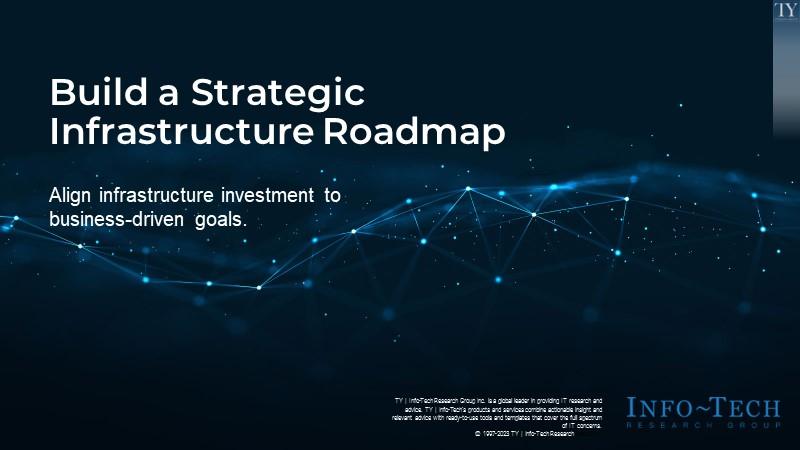
Build a Strategic Infrastructure Roadmap
Getting a seat at the table is your first objective in building a strategic roadmap. Knowing what the business wants to do and understanding what it will need in the future is a challenge for most IT departments.
This could be a challenge such as:
- Understanding the business vision
- Clear communications on business planning
- Insight into what the future state should look like
- Understanding what the IT team is spending its time on day to day
Our Advice
Critical Insight
- Having a clear vision of what the future state is and knowing that creating an IT Infrastructure roadmap is never finished will give your IT team an understanding of priorities, goals, business vision, and risks associated with not planning.
- Understand what you are currently paying for and why.
Impact and Result
- Understanding of the business priorities, and vision of the future
- Know what your budget is spent on: running the business, growth, or innovation
- Increased communication with the right stakeholders
- Better planning based on analysis of time study, priorities, and business goals
Build a Strategic Infrastructure Roadmap Research & Tools
Besides the small introduction, subscribers and consulting clients within this management domain have access to:
1. Build a Strategic Infrastructure Roadmap Storyboard – Improve and align goals and strategy.
In this section you will develop a vision and mission statement and set goals that align with the business vision and goals. The outcome will deliver your guiding principles and a list of goals that will determine your initiatives and their priorities.
- Build Your Infrastructure Roadmap Storyboard
- Strategic Infrastructure Roadmap Tool
2. Financial Spend Analysis Template – Envision future and analyze constraints.
Consider your future state by looking at technology that will help the business in the future. Complete an analysis of your past spending to determine your future spend. Complete a SWOT analysis to determine suitability.
- Financial Spend Analysis Template
3. Strategic Roadmap Initiative Template – Align and build the roadmap.
Develop a risk framework that may slow or hinder your strategic initiatives from progressing and evaluate your technical debt. What is the current state of your infrastructure? Generate and prioritize your initiatives, and set dates for completion.
- Strategic Roadmap Initiative Template
4. Infrastructure and Strategy Executive Brief Template – Communicate and improve the process.
After creating your roadmap, communicate it to your audience. Identify who needs to be informed and create an executive brief with the template download. Finally, create KPIs to measure what success looks like.
- Infrastructure Strategy and Roadmap Executive Presentation Template
- Infrastructure Strategy and Roadmap Report Template
Infographic
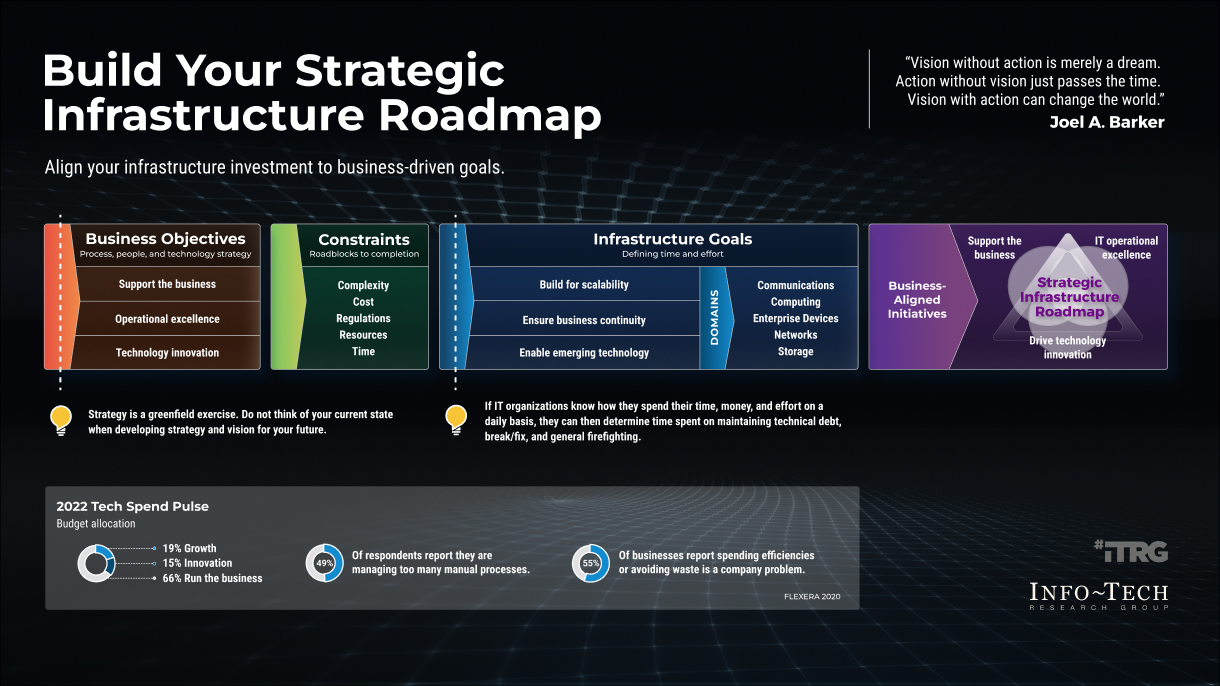
Further reading
Build a Strategic Infrastructure Roadmap
Align infrastructure investment to business-driven goals.
Analysts' Perspectives
Infrastructure roadmaps are an absolute necessity for all organizations. An organization's size often dictates the degree of complexity of the roadmap, but they all strive to paint the future picture of the organization's IT infrastructure.
Infrastructure roadmaps typically start with the current state of infrastructure and work on how to improve. That thinking must change! Start with the future vision, an unimpeded vision, as if there were no constraints. Now you can see where you want to be.
Look at your past to determine how you have been spending your infrastructure budget. If your past shows a trend of increased operational expenditures, that trend will likely continue. The same is true for capital spending and staffing numbers.
Now that you know where you want to go, and how you ended up where you are, look at the constraints you must deal with and make a plan. It's not as difficult as it may seem, and even the longest journey begins with one step.
Speaking of that first step, it should be to understand the business goals and align your roadmap with those same goals. Now you have a solid plan to develop a strategic infrastructure roadmap; enjoy the journey!
There are many reasons why you need to build a strategic IT infrastructure roadmap, but your primary objectives are to set the long-term direction, build a framework for decision making, create a foundation for operational planning, and be able to explain to the business what you are planning. It is a basis for accountability and sets out goals and priorities for the future.
Other than knowing where you are going there are four key benefits to building the roadmap.
- It allows you to be strategic and transformative rather than tactical and reactive.
- It gives you the ability to prioritize your tasks and projects in order to get them going.
- It gives you the ability to align your projects to business outcomes.
- Additionally, you can leverage your roadmap to justify your budget for resources and infrastructure.
When complete, you will be able to communicate to your fellow IT teams what you are doing and get an understanding of possible business- or IT-related roadblocks, but overall executing on your roadmap will demonstrate to the business your competencies and ability to succeed.

PJ Ryan
Research Director
Infrastructure & Operations Practice
Info-Tech Research Group

John Donovan
Principal Research Director
Infrastructure & Operations Practice
Info-Tech Research Group
Build a Strategic Infrastructure Roadmap
Align infrastructure investment to business-driven goals.
EXECUTIVE BRIEF
Executive Summary
Your Challenge
When it comes to building a strategic roadmap, getting a seat at the table is your first objective. Knowing what the business wants to do and understanding its future needs is a challenge for most IT organizations.
Challenges such as:
- Understanding the business vision
- Clear communications on business planning
- Insight into what the future state should look like
Common Obstacles
Fighting fires, keeping the lights on, patching, and overseeing legacy debt maintenance – these activities prevent your IT team from thinking strategically and looking beyond day-to-day operations. Issues include:
- Managing time well
- Building the right teams
- Setting priorities
Procrastinating when it comes to thinking about your future state will get you nowhere in a hurry.
Info-Tech's Approach
Look into your past IT spend and resources that are being utilized.
- Analyze all aspects of the operation, and resources required.
- Be realistic with your timelines.
- Work from the future state backward.
Build your roadmap by setting priorities, understanding risk and gaps both in finance and resources. Overall, your roadmap is never done, so don't worry if you get it wrong on the first pass.
Info-Tech Insight
Have a clear vision of what the future state is, and know that when creating an IT infrastructure roadmap, it is never done. This will give your IT team an understanding of priorities, goals, business vision, and risks associated with not planning. Understand what you are currently paying for and why.
Insight Summary
"Planning is bringing the future into the present so that you can do something about it now."
Source: Alan Lakein, Libquotes
Your strategic objectives are key to building a roadmap
Many organizations' day-to-day IT operations are tactical and reactive. This needs to change; the IT team needs to become strategic and proactive in its planning and execution. Forward thinking bridges the gap from your current state, to what the organization is, to what it wants to achieve. Your strategic objectives need to align to the business vision and goals and keep it running.
Your future state will determine your roadmap priorities
Identify what the business needs to meet its goals; this should be reflected in your roadmap priorities. Then identify the tasks and projects that can get you there. Business alignment is key, as these projects require prioritization. Strategic initiatives that align to business outcomes will be your foundation for planning on those priorities. If you do not align your initiatives, you will end up spinning your wheels. A good strategic roadmap will have all the elements of forward thinking and planning to execute with the right resources, right priorities, and right funding to make it happen.
Understand what you have been paying for the last few years
Measure the cost of "keeping the lights on" as a baseline for your budget that is earmarked and already spent. Determine if your current spend is holding back innovation due to:
- The high cost of maintenance
- Resources in operations doing low-value work due to the effort required to do tasks related to break/fix on aging hardware and software
A successful strategic roadmap will be determined when you have a good handle on your current spending patterns and planning for future needs that include resources, budget, and know-how. Without a plan and roadmap, that plan will not get business buy-in or funding.
Top challenges reported by Info-Tech members
Lack of strategic direction
- Infrastructure leadership must discover the business goals.
Time seepage
- Project time is constantly being tracked incorrectly.
Technical debt
- Aging equipment is not proactively cycled out with newer enabling technologies.
Case Study
The strategic IT roadmap allows Dura to stay at the forefront of automotive manufacturing.
INDUSTRY: Manufacturing
SOURCE: Performance Improvement Partners
Challenge
Following the acquisition of Dura, MiddleGround aimed to position Dura as a leader in the automotive industry, leveraging the company's established success spanning over a century.
However, prior limited investments in technology necessitated significant improvements for Dura to optimize its processes and take advantage of digital advancements.
Solution
MiddleGround joined forces with PIP to assess technology risks, expenses, and prospects, and develop a practical IT plan with solutions that fit MiddleGround's value-creation timeline.
By selecting the top 15 most important IT projects, the companies put together a feasible technology roadmap aimed at advancing Dura in the manufacturing sector.
Results
Armed with due diligence reports and a well-defined IT plan, MiddleGround and Dura have a strategic approach to maximizing value creation.
By focusing on key areas such as analysis, applications, infrastructure and the IT organization, Dura is effectively transforming its operations and shaping the future of the automotive manufacturing industry.
How well do you know your business strategy?
A mere 25% of managers
can list three of the company's
top five priorities.
Based on a study from MIT Sloan, shared understanding of strategic directives barely exists beyond the top tiers of leadership.
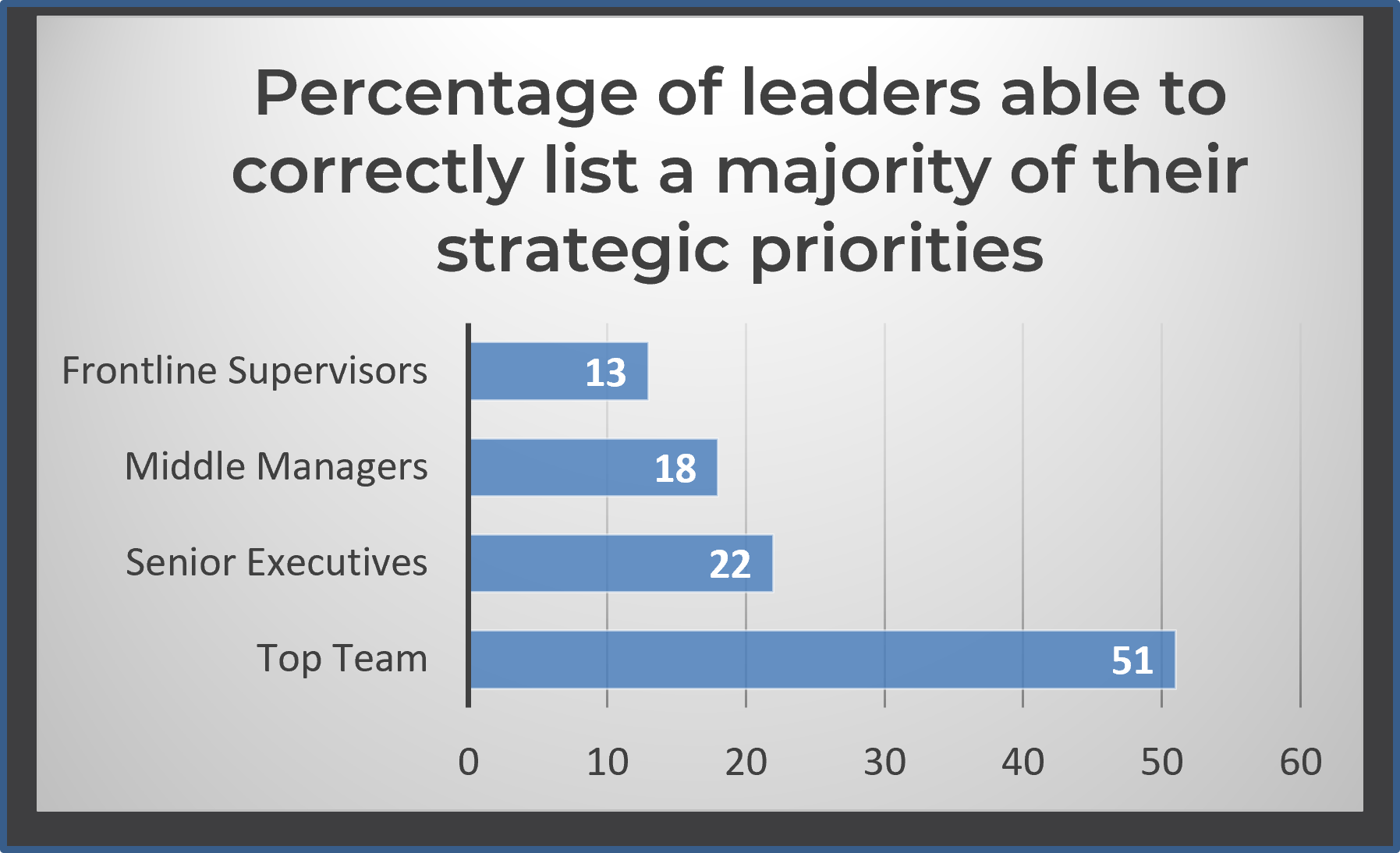
Take your time back
Unplanned incident response is a leading cause of the infrastructure time crunch, but so too are nonstandard service requests and service requests that should be projects.
29% |
Less than one-third of all IT projects finish on time. |
|---|---|
200% |
85% of IT projects average cost overruns of 200% and time overruns of 70%. |
70% |
70% of IT workers feel as though they have too much work and not enough time to do it. |
Source: MIT Sloan
Inventory Assessment
Lifecycle
Refresh strategies are still based on truisms (every three years for servers, every seven years for LAN, etc.) more than risk-based approaches.
Opportunity Cost
Assets that were suitable to enable business goals need to be re-evaluated as those goals change.
See Info-Tech's Manage Your Technical Debt blueprint
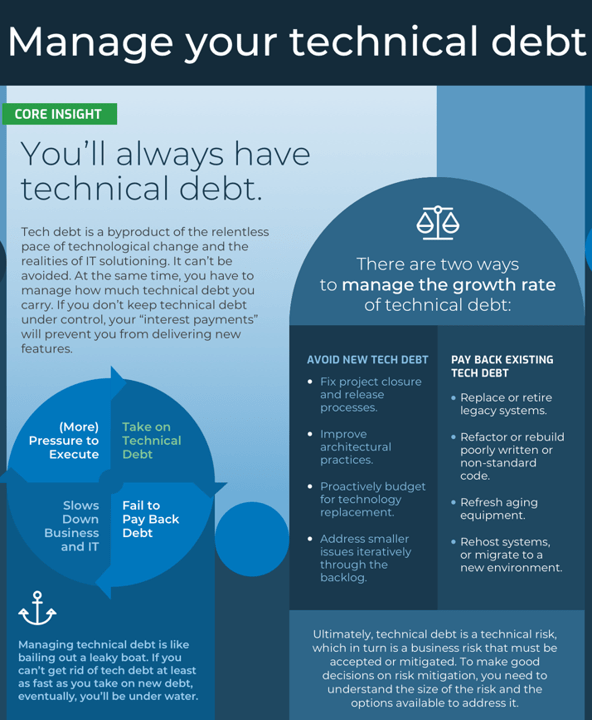
Key IT strategy initiatives can be categorized in three ways
IT key initiative plan
Initiatives collectively support the business goals and corporate initiatives, and improve the delivery of IT services.
- Business support
- Support major business initiatives
- Each corporate initiative is supported by a major IT project and each project has unique IT challenges that require IT support.
- IT excellence
- Reduce risk and improve IT operational excellence
- These projects will increase IT process maturity and will systematically improve IT.
- Innovation
- Drive technology innovation
- These projects will improve future innovation capabilities and decrease risk by increasing technology maturity.
Info-Tech Insight
A CIO has three roles: enable business productivity, run an effective IT shop, and drive technology innovation. Your key initiative plan must reflect these three mandates and how IT strives to fulfill them.
IT must accomplish many things
Manage
the lifecycle of aging equipment against current capacity and capability demands.
Curate
a portfolio of enabling technologies to meet future capacity and capability demands.
Initiate
a realistic schedule of initiatives that supports a diverse range of business goals.
Adapt
to executive feedback and changing business goals.
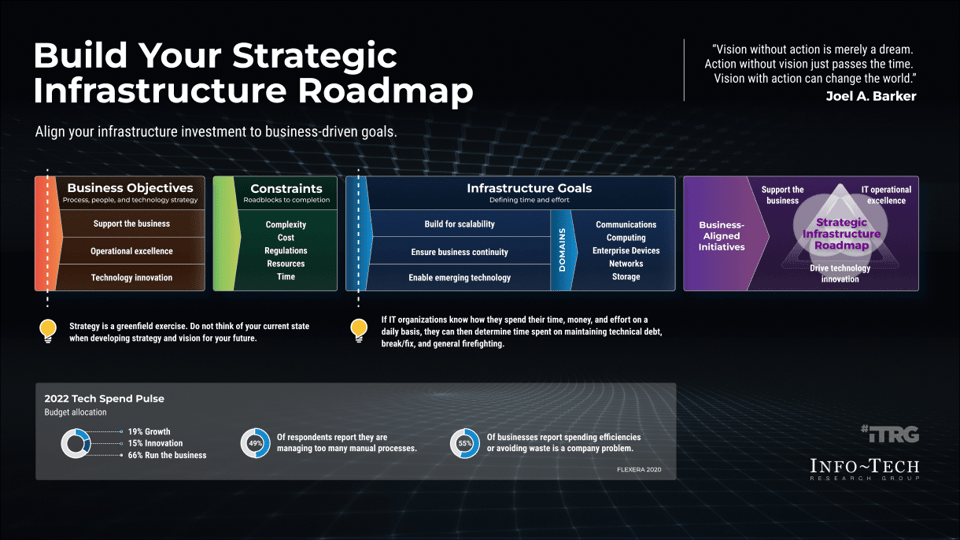
Primary and secondary infrastructure drivers
- Primary driver – The infrastructure component that is directly responsible for enabling change in the business metric.
- Secondary driver – The infrastructure component(s) that primary drivers rely on.
(Source: BMC)
Sample primary and secondary drivers
| Business metric | Source(s) | Primary infrastructure drivers | Secondary infrastructure drivers |
|---|---|---|---|
Sales revenue |
Online store |
Website/Server (for digital businesses) |
|
# of new customers |
Call center |
Physical plant cabling in the call center |
|
Info-Tech Insight
You may not be able to directly influence the primary drivers of the business, but your infrastructure can have a major impact as a secondary driver.
Info-Tech's approach
- Align strategy and goals
- Establish the scope of your IT strategy by defining IT's mission and vision statements and guiding principles.
- Envision and define your future infrastructure and analyze what is holding you back.
- Establish a risk framework, identify initiatives, and build your strategic infrastructure roadmap.
- Communicate the results of your hard work to the right people and establish the groundwork for continual improvement of the process.
Blueprint deliverables
Each step of this blueprint is accompanied by supporting deliverables to help you accomplish your goals:
Mission and Vision Statement
Goal Alignment (Slide 28)
Construct your vision and mission aligned to the business.
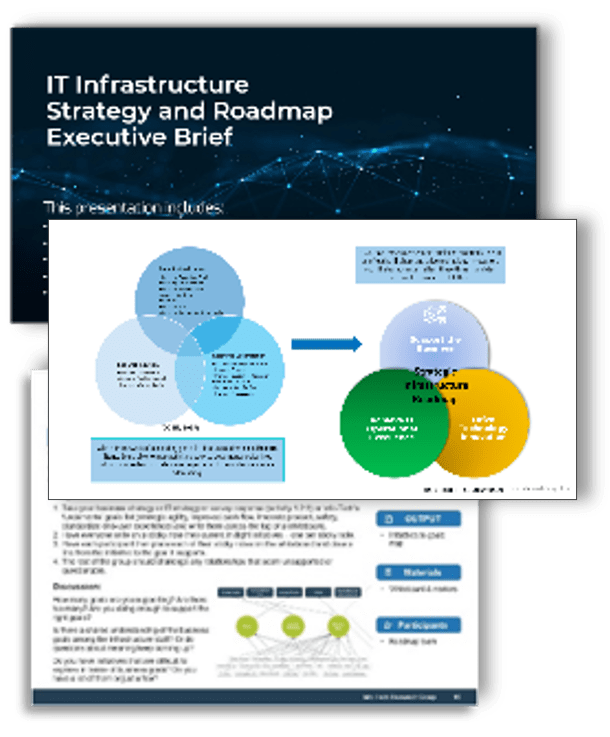
Strategic Infrastructure Roadmap tool
Build initiatives and prioritize them. Build the roadmap.
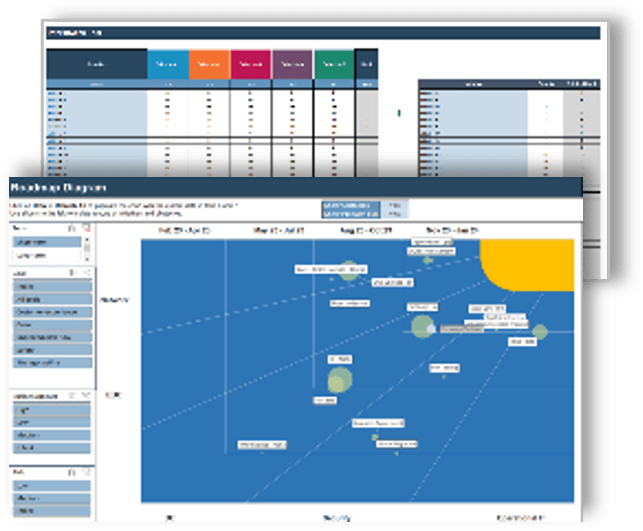
Infrastructure Domain Study
What is stealing your time from getting projects done?
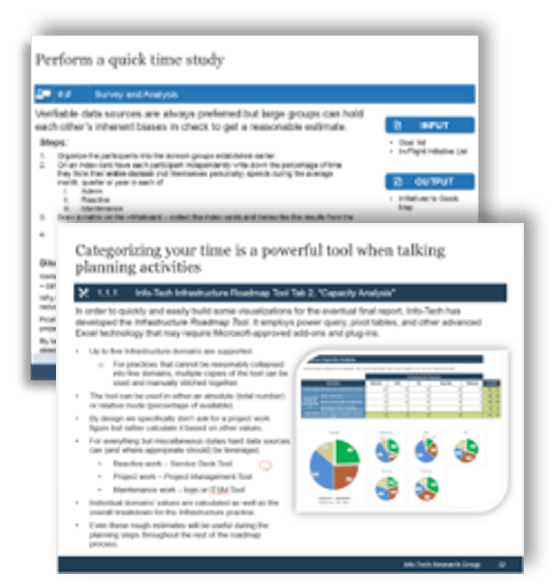
Initiative Templates Process Maps & Strategy
Build templates for initiates, build process map, and develop strategies.
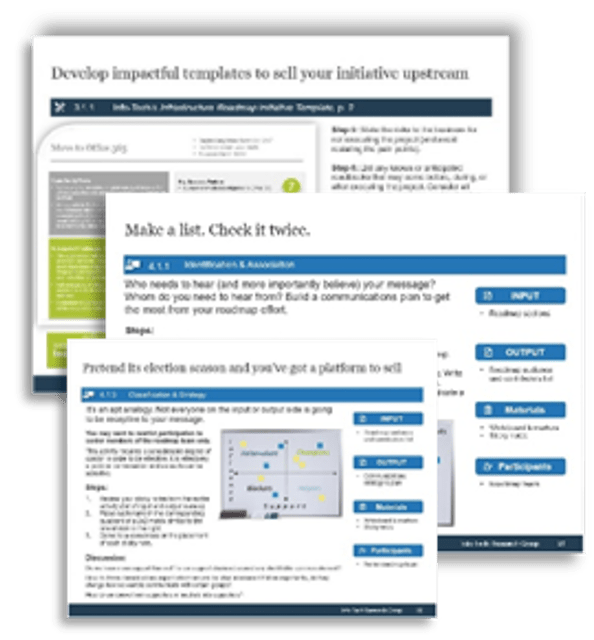
Key Deliverable
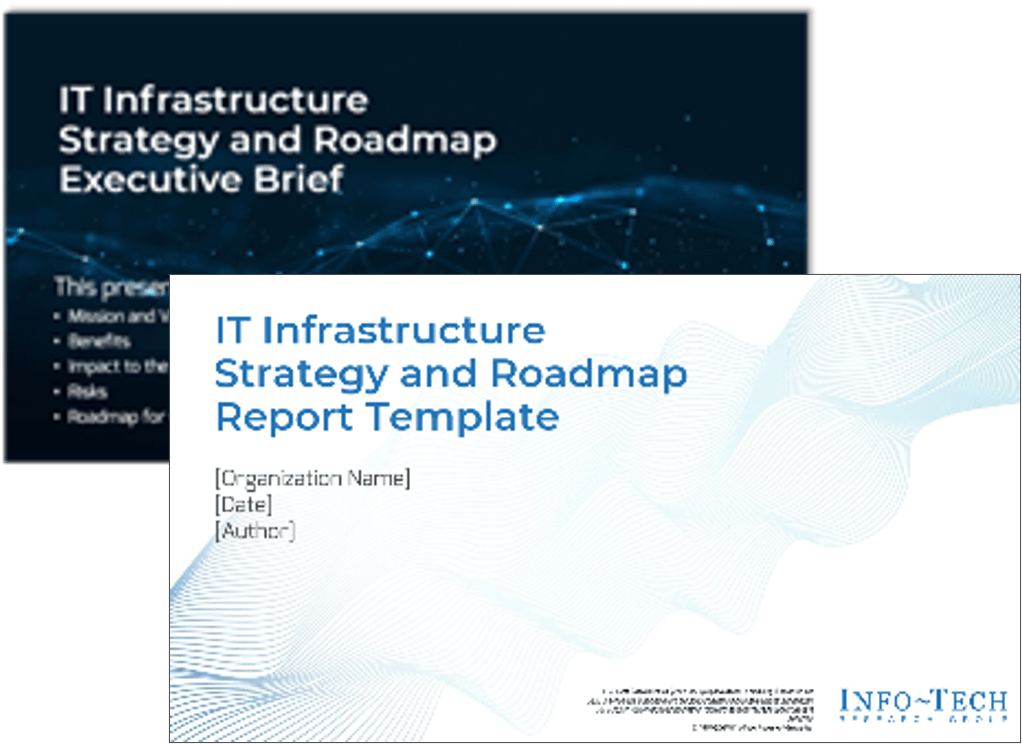
Info-Tech offers various levels of support to best suit your needs
DIY Toolkit
“Our team has already made this critical project a priority, and we have the time and capability, but some guidance along the way would be helpful.”
Guided Implementation
“Our team knows that we need to fix a process, but we need assistance to determine where to focus. Some check-ins along the way would help keep us on track.”
Workshop
“We need to hit the ground running and get this project kicked off immediately. Our team has the ability to take this over once we get a framework and strategy in place.”
Consulting
“Our team does not have the time or the knowledge to take this project on. We need assistance through the entirety of this project.”
Diagnostics and consistent frameworks used throughout all four options
Info-Tech's methodology for an infrastructure strategy and roadmap
1. Align Strategy and Goals |
2. Envision Future and Analyze Constraints |
3. Align and Build the Roadmap |
4. Communicate and Improve the Process |
|
|---|---|---|---|---|
Phase steps |
1.1 Develop the infrastructure strategy 1.2 Define the goals |
2.1 Define the future state 2.2 Analyze constraints |
3.1 Align the roadmap 3.2 Build the roadmap |
4.1 Identify the audience 4.2 Improve the process |
Phase Outcomes |
|
|
|
|
Guided Implementation
What does a typical GI on this topic look like?
| Phase 0 | Phase 1 | Phase 2 | Phase 3 | Phase 4 |
|---|---|---|---|---|
Call #1: Scope requirements, objectives, and your specific challenges. |
Call #2: Define mission and vision statements and guiding principles to discuss strategy scope. |
Call #4: Conduct a spend analysis and a time resource study. |
Call #6: Develop a risk framework and address technical debt. |
Call #10: Identify your audience and communicate. |
A Guided Implementation (GI) is a series of calls with an Info-Tech analyst to help implement our best practices in your organization.
A typical GI is 8 to 12 calls over the course of 4 to 6 months.
Workshop Overview
Contact your account representative for more information.
workshops@infotech.com 1-888-670-8889
Session 0 (Pre-workshop) |
Session 1 |
Session 2 |
Session 3 |
Session 4 |
Session 5 (Post-workshop) |
|---|---|---|---|---|---|
| Elicit business context | Align Strategy and Goals | Envision Future and Analyze Constraints | Align and Build the Roadmap | Communicate and Improve the Process | Wrap-up (offsite) |
0.1 Complete recommended diagnostic programs. |
1.1 Infrastructure strategy. 1.2 Business goal alignment |
2.1 Define the future state. 2.2 Analyze your constraints |
3.1 Align the roadmap 3.2 Build the roadmap. |
4.2 Identify the audience 4.2 Improve the process |
5.1 Complete in-progress deliverables from previous four days. |
|
|
|
|
|
|
Phase 1
Align Strategy and Goals
Phase 1 | Phase 2 | Phase 3 | Phase 4 |
|---|---|---|---|
1.1 Infrastructure strategy 1.2 Goal alignment | 2.1 Define your future 2.2 Conduct constraints analysis | 3.1 Drive business alignment 3.2. Build the roadmap | 4.1 Identify the audience 4.2 Process improvement and measurements |
This phase will walk you through the following activities:
- How to build IT mission and vision statements
- How to elicit IT guiding principles
- How to finalize and communicate your IT strategy scope
This phase involves the following participants:
- CIO
- Senior IT Team
Step 1.1
Develop the Infrastructure Strategy
Activities
1.1.1 Review/validate the business context
1.1.2 Construct your mission and vision statements
1.1.3 Elicit your guiding principles and finalize IT strategy scope
This step requires the following inputs:
- Business Mission Statement
- Business Vision Statement
- Business Goals
This step involves the following participants:
- Roadmap team
Outcomes of this step
- IT mission statement
- IT vision statement
- Guiding principles
To complete this phase, you will need:
Infrastructure Strategy and Roadmap Report Template
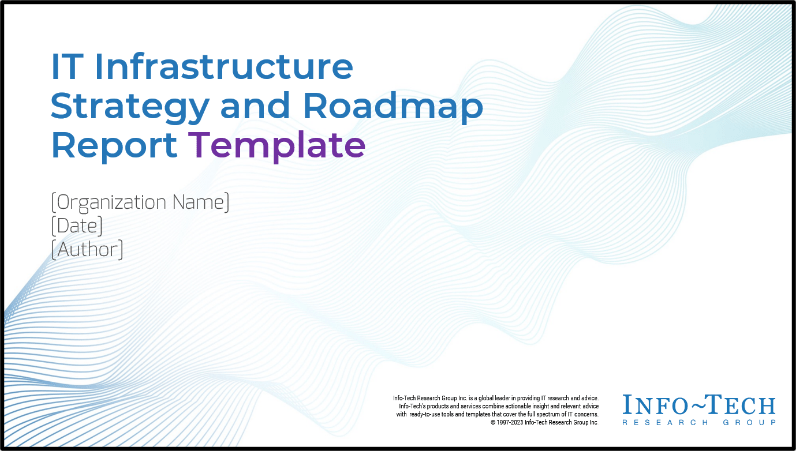
Use the IT Infrastructure Strategy and Roadmap Report Template to document the results from the following activities:
- Mission and Vision Statements
- Business impact
- Roadmap
IT must aim to support the organization's mission and vision
A mission statement
- Focuses on today and what an organization does to achieve the mission.
- Drives the company.
- Answers: What do we do? Who do we serve? How do we service them?
"A mission statement focuses on the purpose of the brand; the vision statement looks to the fulfillment of that purpose."
A vision statement
- Focuses on tomorrow and what an organization ultimately wants to become.
- Gives the company direction.
- Answers: What problems are we solving? Who and what are we changing?
"A vision statement provides a concrete way for stakeholders, especially employees, to understand the meaning and purpose of your business. However, unlike a mission statement – which describes the who, what, and why of your business – a vision statement describes the desired long-term results of your company's efforts."
Source: Business News Daily, 2020
Characteristics of mission and vision statements
A strong mission statement has the following characteristics:
- Articulates the IT function's purpose and reason for existence.
- Describes what the IT function does to achieve its vision.
- Defines the customers of the IT function.
- Is:
- Compelling
- Easy to grasp
- Sharply focused
- Concise
A strong vision statement has the following characteristics:
- Describes a desired future achievement.
- Focuses on ends, not means.
- Communicates promise.
- Is:
- Concise; no unnecessary words
- Compelling
- Achievable
- Measurable
Derive the IT mission and vision statements from the business
Begin the process by identifying and locating the business mission and vision statements.
- Corporate websites
- Business strategy documents
- Business executives
Ensure there is alignment between the business and IT statements.
Note: Mission statements may remain the same unless the IT department's mandate is changing.
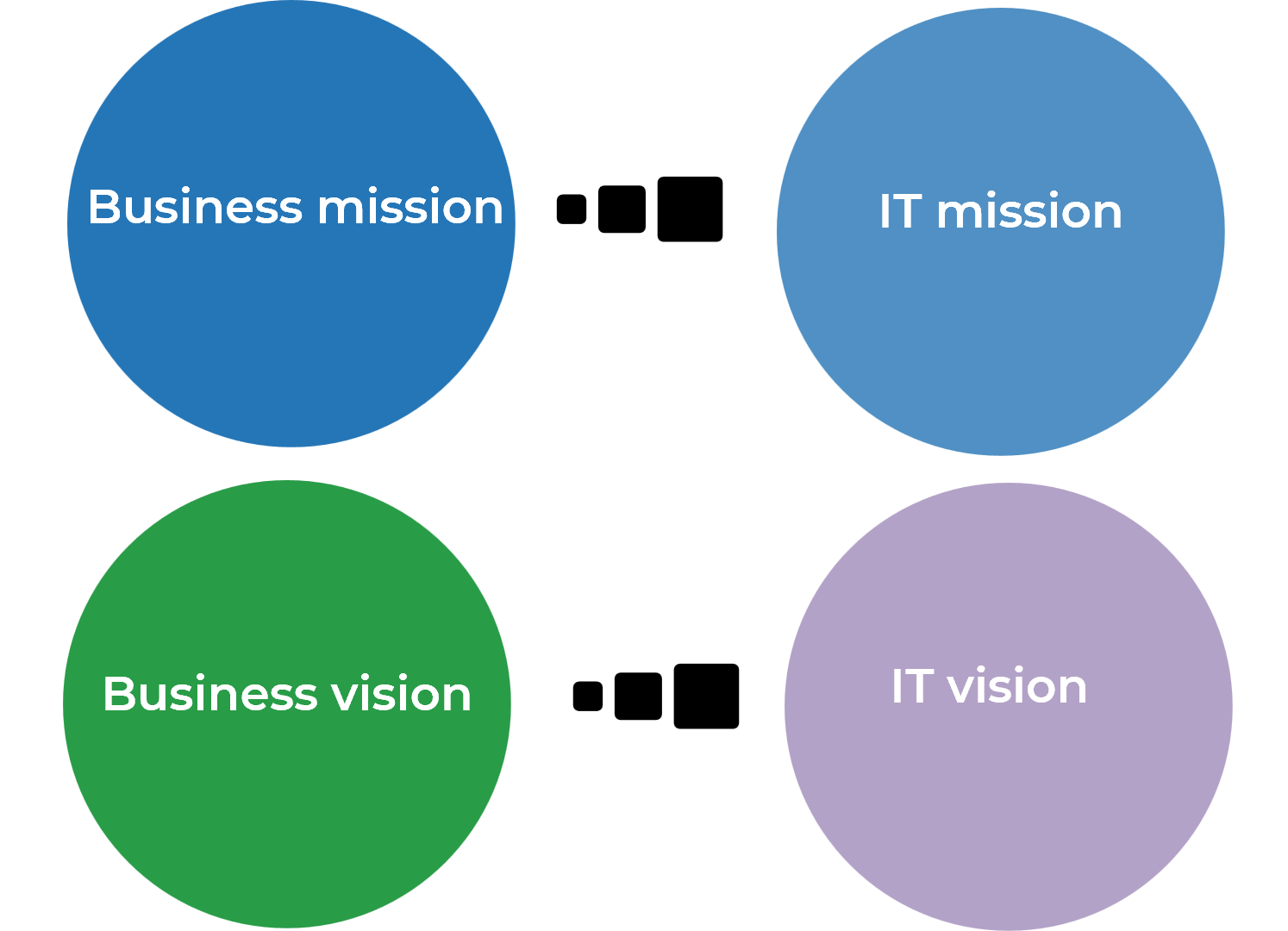
1.1.2 Construct mission and vision statements
1 hour
Objective: Help teams define their purpose (why they exist) to build a mission statement (if one doesn't already exist).
Step 1:
- Gather the IT strategy creation team and revisit your business context inputs, specifically the corporate mission statement.
- Begin by asking the participants:
- What is our job as a team?
- What's our goal? How do we align IT to our corporate mission?
- What benefit are we bringing to the company and the world?
- Ask them to share general thoughts in a check-in.
Step 2:
- Share some examples of IT mission statements.
- Example: IT provides innovative product solutions and leadership that drives growth and
success. - Provide each participant with some time to write their own version of an IT mission statement.
Download the ITRG IT Infrastructure Strategy and Roadmap Report Template and document your mission and vision statements in Section 1.
Input
- Business vision statement
- Business mission statement
Output
- IT mission statement
- IT vision statement
Materials
- Sticky notes
- Markers
- Whiteboard
- Paper
- Collaboration/brain-storming tool (whiteboard, flip chart, digital equivalent)
Participants
- CIO
- Senior IT Team
1.1.2 Construct mission and vision statements (cont'd)
1 hour
Objective: Help teams define their purpose (why they exist) to build a mission statement (if one doesn't already exist).
Step 3:
This step involves reviewing individual mission statements, combining them, and building one collective mission statement for the team.
- Consider the following approach to build a unified mission statement:
Use the 20x20 rule for group decision-making. Give the group no more than 20 minutes to craft a collective team purpose with no more than 20 words.
- As a facilitator, provide guidelines on how to write for the intended audience. Business stakeholders need business language.
- Refer to the corporate mission statement periodically and ensure there is alignment.
- Document your final mission statement in your ITRG Infrastructure Strategy and Roadmap Report Template.
Download the ITRG IT Infrastructure Strategy and Roadmap Report Template and document your mission and vision statements in Section 1.
Input
- Business vision statement
- Business mission statement
Output
- IT mission statement
- IT vision statement
Materials
- Sticky notes
- Markers
- Whiteboard
- Paper
- Collaboration/brain-storming tool (whiteboard, flip chart, digital equivalent)
Participants
- CIO
- Senior IT Team
1.1.2 Construct mission and vision statements (cont'd)
1 hour
Objective: Help teams define their purpose (why they exist) to build a mission statement (if one doesn't already exist).
Step 4:
- Gather the IT strategy creation team and revisit your business context inputs, specifically the corporate vision statement.
- Share one or more examples of vision statements.
- Provide participants with sticky notes and writing materials and ask them to work individually for this step.
- Ask participants to brainstorm:
- What is the desired future state of the IT organization?
- How should we work to attain the desired state?
- How do we want IT to be perceived in the desired state?
- Provide participants with guidelines to build descriptive, compelling, and achievable statements regarding their desired future state.
- Regroup as a team and review participant answers.
Download the ITRG IT Infrastructure Strategy and Roadmap Report Template and document your mission and vision statements in Section 1.
Input
- Business vision statement
- Business mission statement
Output
- IT mission statement
- IT vision statement
Materials
- Sticky notes
- Markers
- Whiteboard
- Paper
- Collaboration/brain-storming tool (whiteboard, flip chart, digital equivalent)
Participants
- CIO
- Senior IT Team
1.1.2 Construct mission and vision statements (cont'd)
1 hour
Objective: Help teams define their purpose (why they exist) to build a mission statement (if one doesn't already exist).
Step 5:
- Ask the team to post their notes on the wall.
- Have the team group the words that have a similar meaning or feeling behind them; this will create themes.
- When the group is done categorizing the statements into themes, ask if there's anything missing. Did they ensure alignment to the corporate vision statement? Are there any elements missing when considering alignment back to the corporate vision statement?
Step 6:
- Consider each category as a component of your vision statement.
- Review each category with participants; define what the behavior looks like when it is being met and what it looks like when it isn't.
- As a facilitator, provide guidelines on word-smithing and finessing the language.
- Refer to the corporate vision statement periodically and ensure there is alignment.
- Document your final mission statement in your IT Strategy Presentation Template.
Download the ITRG IT Infrastructure Strategy and Roadmap Report Template and document your mission and vision statements in Section 1.
Input
- Business vision statement
- Business mission statement
Output
- IT mission statement
- IT vision statement
Materials
- Sticky notes
- Markers
- Whiteboard
- Paper
- Collaboration/brain-storming tool (whiteboard, flip chart, digital equivalent)
Participants
- CIO
- Senior IT Team
1.1.2 Construct mission and vision statements (cont'd)
Tips for online facilitation:
- Pick an online whiteboard tool that allows participants to use a large, zoomable canvas.
- Set up each topic at a different area of the board; spread them out just like you would do on the walls of a room.
- Invite participants to zoom in and visit each section and add their ideas as sticky notes once you reach that section of the exercise.
- If you're not using an online whiteboard, we'd recommend using a collaboration tool such as Google Docs or Teams Whiteboard to collect the information for each step under a separate heading. Invite everyone into the document but be very clear regarding editing rights.
- Pre-create your screen deck and screen share this with your participants through your videoconferencing software. We'd also recommend sharing this so participants can go through the deck again during the reflection steps.
- When facilitating group discussion, we'd recommend that participants use non-verbal means to indicate they'd like to speak. You can use tools like Teams' hand-raising tool, a reaction emoji, or have people put their hands up. The facilitator can then invite that person to talk.
Source: Hyper Island
Input
- Business vision statement
- Business mission statement
Output
- IT mission statement
- IT vision statement
Materials
- Sticky notes
- Markers
- Whiteboard
- Paper
- Collaboration/brainstorming tool (whiteboard, flip chart, digital equivalent)
Participants
- CIO
- Senior IT Team
IT mission statements demonstrate IT's purpose
The IT mission statement specifies the function's purpose or reason for being. The mission should guide each day's activities and decisions. The mission statements use simple and concise terminology and speak loudly and clearly, generating enthusiasm for the organization.
Strong IT mission statements have the following characteristics:
- Articulate the IT function's purpose and reason for existence
- Describe what the IT function does to achieve its vision
- Define the customers of the IT function
- Are:
- Compelling
- Easy to grasp
- Sharply focused
- Inspirational
- Memorable
- Concise
Sample IT Mission Statements:
- To provide infrastructure, support, and innovation in the delivery of secure, enterprise-grade information technology products and services that enable and empower the workforce at [Company Name].
- To help fulfill organizational goals, the IT department is committed to empowering business stakeholders with technology and services that facilitate effective processes, collaboration, and communication.
- The mission of the information technology (IT) department is to build a solid, comprehensive technology infrastructure; to maintain an efficient, effective operations environment; and to deliver high-quality, timely services that support the business goals and objectives of ABC Inc.
- The IT department has operational, strategic, and fiscal responsibility for the innovation, implementation, and advancement of technology at ABC Inc. in three main areas: network administration and end-user support, instructional services, and information systems. The IT department provides leadership in long-range planning, implementation, and maintenance of information technology across the organization.
- The IT group is customer-centered and driven by its commitment to management and staff. It oversees services in computing, telecommunications, networking, administrative computing, and technology training.
Sample mission statements (cont'd)
- To collaborate and empower our stakeholders through an engaged team and operational agility and deliver innovative technology and services.
- To empower our stakeholders with innovative technology and services, through collaboration and agility.
- To collaborate and empower our stakeholder, by delivering innovative technology and services, with an engaged team and operational agility.
- To partner with departments and be technology leaders that will deliver innovative, secure, efficient, and cost-effective services for our citizens.
- As a client-centric strategic partner, provide excellence in IM and IT services through flexible business solutions for achieving positive user experience and satisfaction.
- Develop a high-performing global team that will plan and build a scalable, stable operating environment.
- Through communication and collaboration, empower stakeholders with innovative technology and services.
- Build a robust portfolio of technology services and solutions, enabling science-lead and business-driven success.
- Guided by value-driven decision making, high-performing teams and trusted partners deliver and continually improve secure, reliable, scalable, and reusable services that exceed customer expectations.
- Engage the business to grow capabilities and securely deliver efficient services to our users and clients.
- Engage the business to securely deliver efficient services and grow capabilities for our users and clients.
IT vision statements demonstrate what the IT organization aspires to be
The IT vision statement communicates a desired future state of the IT organization. The statement is expressed in the present tense. It seeks to articulate the desired role of IT and how IT will be perceived.
Strong IT vision statements have the following characteristics:
- Describe a desired future
- Focus on ends, not means
- Communicate promise
- Are:
- Concise; no unnecessary words
- Compelling
- Achievable
- Inspirational
- Memorable
Sample IT vision statements:
- To be a trusted advisor and partner in enabling business innovation and growth through an engaged IT workforce.
- The IT organization will strive to become a world-class value center that is a catalyst for innovation.
- IT is a cohesive, proactive, and disciplined team that delivers innovative technology solutions while demonstrating a strong customer-oriented mindset.
- Develop and maintain IT and an IT support environment that is secure, stable, and reliable within a dynamic environment.
Sample vision statements (cont'd)
- Alignment: To ensure that the IT organizational model and all related operational services and duties are properly aligned with all underlying business goals and objectives. Alignment reflects an IT operation "that makes sense," considering the business served, its interests and its operational imperatives.
- Engagement: To ensure that all IT vision stakeholders are fully engaged in technology-related planning and the operational parameters of the IT service portfolio. IT stakeholders include the IT performing organization (IT Department), company executives and end-users.
- Best Practices: To ensure that IT operates in a standardized fashion, relying on practical management standards and strategies properly sized to technology needs and organizational capabilities.
- Commitment to Customer Service: To ensure that IT services are provided in a timely, high-quality manner, designed to fill the operational needs of the front-line end-users, working within the boundaries established by business interests and technology best practices.
Quoted From ITtoolkit, 2020
Case Study
Acme Corp. was able to construct its IT mission and vison statements by aligning to its corporate mission and vision.
INDUSTRY: Professional Services
COMPANY: This case study is based on a real company but was anonymized for use in this research.
Business |
IT | ||
|---|---|---|---|
Mission |
Vision |
Mission |
Vision |
We help IT leaders achieve measurable results by systematically improving core IT processes, governance, and critical technology projects. |
Acme Corp. will grow to become the largest research firm across the industry by providing unprecedented value to our clients. |
IT provides innovative product solutions and leadership that drives growth and success. |
We will relentlessly drive value to our customers through unprecedented innovation. |
IT guiding principles set the boundaries for your strategy
Strategic guiding principles advise the IT organization on the boundaries of the strategy.
Guiding principles are a priori decisions that limit the scope of strategic thinking to what is acceptable organizationally, from budgetary, people, and partnership standpoints. Guiding principles can cover other dimensions, as well.
Organizational stakeholders are more likely to follow IT principles when a rationale is provided.
After defining the set of IT principles, ensure that they are all expanded upon with a rationale. The rationale ensures principles are more likely to be followed because they communicate why the principles are important and how they are to be used. Develop the rationale for each IT principle your organization has chosen.
IT guiding principles = IT strategy boundaries
Consider these four components when brainstorming guiding principles
Breadth
of the IT strategy can span across the eight perspectives: people, process, technology, data, process, sourcing, location, and timing.
Defining which of the eight perspectives is in scope for the IT strategy is crucial to ensuring the IT strategy will be comprehensive, relevant, and actionable.
Depth
of coverage refers to the level of detail the IT strategy will go into for each perspective. Info-Tech recommends that depth should go to the initiative level (i.e. individual projects).
Organizational coverage
will determine which part of the organization the IT strategy will cover.
Planning horizon
of the IT strategy will dictate when the target state should be reached and the length of the roadmap.
Consider these criteria when brainstorming guiding principle statements
| Approach focused | IT principles are focused on the approach, i.e. how the organization is built, transformed, and operated, as opposed to what needs to be built, which is defined by both functional and non-functional requirements. |
|---|---|
| Business relevant | Create IT principles that are specific to the organization. Tie IT principles to the organization's priorities and strategic aspirations. |
| Long lasting | Build IT principles that will withstand the test of time. |
| Prescriptive | Inform and direct decision-making with IT principles that are actionable. Avoid truisms, general statements, and observations. |
| Verifiable | If compliance can't be verified, the principle is less likely to be followed. |
| Easily digestible | IT principles must be clearly understood by everyone in IT and by business stakeholders. IT principles aren't a secret manuscript of the IT team. IT principles should be succinct; wordy principles are hard to understand and remember. |
| Followed | Successful IT principles represent a collection of beliefs shared among enterprise stakeholders. IT principles must be continuously reinforced to all stakeholders to achieve and maintain buy-in. In organizations where formal policy enforcement works well, IT principles should be enforced through appropriate governance processes. |
Review ten universal IT principles to determine if your organization wishes to adopt them
IT principle name |
IT principle statement |
|---|---|
| 1. Enterprise value focus | We aim to provide maximum long-term benefits to the enterprise as a whole while optimizing total costs of ownership and risks. |
| 2. Fit for purpose | We maintain capability levels and create solutions that are fit for purpose without over engineering them. |
| 3. Simplicity | We choose the simplest solutions and aim to reduce operational complexity of the enterprise. |
| 4. Reuse > buy > build | We maximize reuse of existing assets. If we can't reuse, we procure externally. As a last resort, we build custom solutions. |
| 5. Managed data | We handle data creation, modification, and use enterprise-wide in compliance with our data governance policy. |
| 6. Controlled technical diversity | We control the variety of technology platforms we use. |
| 7. Managed security | We manage security enterprise-wide in compliance with our security governance policy. |
| 8. Compliance to laws and regulations | We operate in compliance with all applicable laws and regulations. |
| 9. Innovation | We seek innovative ways to use technology for business advantage. |
| 10. Customer centricity | We deliver best experiences to our customers with our services and products. |
1.1.3 Elicit guiding principles
1 hour
Objective: Generate ideas for guiding principle statements with silent sticky note writing.
- Gather the IT strategy creation team and revisit your mission and vision statements.
- Ask the group to brainstorm answers individually, silently writing their ideas on separate sticky notes. Provide the brainstorming criteria from the previous slide to all team members. Allow the team to put items on separate notes that can later be shuffled and sorted as distinct thoughts.
- After a set amount of time, ask the members of the group to stick their notes to the whiteboard and quickly present them. Categorize all ideas into four major buckets: breadth, depth, organizational coverage, and planning horizon. Ideally, you want one guiding principle to describe each of the four components.
- If there are missing guiding principles in any category or anyone's items inspire others to write more, they can stick those up on the wall too, after everyone has presented.
- Discuss and finalize your IT guiding principles.
- Document your guiding principles in the IT Strategy Presentation Template in Section 1.
Source: Hyper Island
Download the ITRG IT Infrastructure Strategy and Roadmap Report Template and document your mission and vision statements in Section 1.
Input
- Four components for eliciting guiding principles
- Mission and vision statements
Output
- IT guiding principles
- IT strategy scope
Materials
- Sticky notes
- Whiteboard
- Paper
- Collaboration/brain-storming tool (whiteboard, flip chart, digital equivalent)
Participants
- CIO
- Senior IT Team
Guiding principle examples
- Alignment: Our IT decisions will align with [our organization's] strategic plan.
- Resources: We will allocate cyber-infrastructure resources based on providing the greatest value and benefit for [the community].
- User Focus: User needs will be a key component in all IT decisions.
- Collaboration: We will work within and across organizational structures to meet strategic goals and identify opportunities for innovation and improvement.
- Transparency: We will be transparent in our decision making and resource use.
- Innovation: We will value innovative and creative thinking.
- Data Stewardship: We will provide a secure but accessible data environment.
- IT Knowledge and Skills: We will value technology skills development for the IT community.
- Drive reduced costs and improved services
- Deploy packaged apps – do not develop – retain business process knowledge expertise – reduce apps portfolio
- Standardize/Consolidate infrastructure with key partners
- Use what we sell, and help sell
- Drive high-availability goals: No blunders
- Ensure hardened security and disaster recovery
- Broaden skills (hard and soft) across the workforce
- Improve business alignment and IT governance
Quoted From: Office of Information Technology, 2014; Future of CIO, 2013
Case Study
Acme Corp. elicited guiding principles that set the scope of its IT strategy for FY21.
INDUSTRY: Professional Services
COMPANY: Acme Corp.
The following guiding principles define the values that drive IT's strategy in FY23 and provide the criteria for our 12-month planning horizon.
- We will focus on big-ticket items during the next 12 months.
- We will keep the budget within 5%+/- YOY.
- We will insource over outsource.
- We will develop a cloud-first technology stack.
Finalize your IT strategy scope
Your mission and vision statements and your guiding principles should be the first things you communicate on your IT strategy document.
Why is this important?
- Communicating these elements shows how IT supports the corporate direction.
- The vision and mission statements will clearly articulate IT's aspirations and purpose.
- The guiding principles will clearly articulate how IT plans to support the business strategically.
- These elements set expectations with stakeholders for the rest of your strategy.
Input information into the IT Strategy Presentation Template.
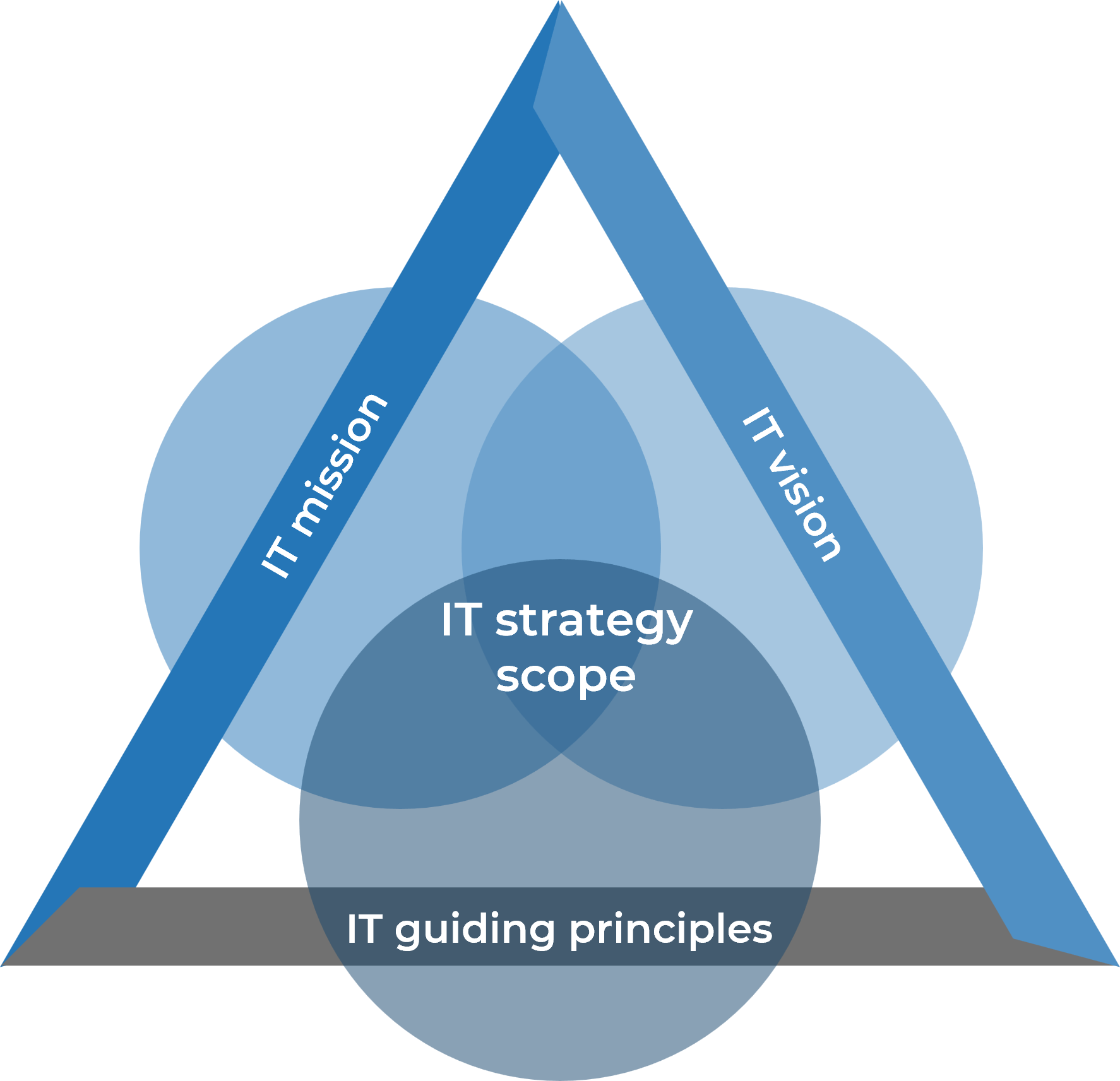
Summary of Accomplishment
Established the scope of your IT strategy
- Constructed the IT mission statement to communicate the IT organization's reason for being.
- Constructed the IT vision statement to communicate the desired future state of the IT organization.
- Elicited IT's guiding principles to communicate the overall scope and time horizon for the strategy.
If you would like additional support, have our analysts guide you through other phases as part of an Info-Tech workshop
Contact your account representative for more information.
workshops@infotech.com 1-888-670-8889
Step 1.2
Business Goal Alignment
Activities
1.2.1 Intake identification and analysis
1.2.2 Survey results analysis
1.2.3 Goal brainstorming
1.2.4 Goal association and analysis
This step requires the following inputs:
- Last year's accomplished project list
- Business unit input source list
- Goal list
- In-flight initiatives list
This step involves the following participants:
- Business leadership
- Project Management Office
- Service Desk
- Business Relationship Management
- Solution or Enterprise Architecture
- Roadmap team
Outcomes of this step
- Intake analysis
- Goal list
- Initiative-to-goal map
Identify who is expecting what from the infrastructure
"Typically, IT thinks in an IT first, business second, way: 'I have a list of problems and if I solve them, the business will benefit.' This is the wrong way of thinking. The business needs to be thought of first, then IT."
– Fred Chagnon, Infrastructure Director,
Info-Tech Research Group
Info-Tech Insight
If you're not soliciting input from or delivering on the needs of the various departments in your company, then who is? Be explicit and track how you communicate with each individual unit within your company.
Mature project portfolio management and enterprise architecture practices are no substitute for understanding your business clientele.
It may not be a democracy, but listening to everyone's voice is an essential step toward generating a useful roadmap.
Building good infrastructure requires an understanding of how it will be used. Explicit consultation with stakeholders maximizes a roadmap's usefulness and holds the enterprise accountable in future roadmap iterations as goals change.
Who are the customers for infrastructure?
Internal customer examples:
- Network Operations manager
- IT Systems manager
- Webmaster
- Security manager
External customer examples:
- Director of Sales
- Operations manager
- Applications manager
- Clients
- Partners and consultants
- Regulators/government
1.2.1 Intake identification and analysis
1 hour
The humble checklist is the single most effective tool to ensure we don't forget someone or something:
- Have everyone write down their top five completed projects from last year – one project per sticky note.
- Organize everyone's sticky notes on a whiteboard according to input source – did these projects come from the PMO? Directly from a BRM? Service request? VP or LoB management?
- Make a MECE list of these sources on the left-hand side of a whiteboard.
- On the right-hand side list all the departments or functional business units within the company.
- Draw lines from right to left indicating which business units use which input source to request work.
- Optional: Rate the efficacy of each input channel – what is the success rate of projects per channel in terms of time, budget, and functionality?
Discussion:
- How clearly do projects and initiatives arrive at infrastructure to be acted on? Do they follow the predictable formal process with all the needed information or is it more ad hoc?
- Can we validate that business units are using the correct input channel to request the appropriate work? Does infrastructure have to spend more time validating the requests of any one channel?
- Can we identify business units that are underserved? How about overserved? Infrastructure initiatives tend to be near universal in effect – are we forgetting anyone?
- Are all these methods passive (order taking), or is there a process for infrastructure to suggest an initiative or project?
Input
- Last year's accomplished project list
Output
- Work requested workflow and map
Materials
- Sticky notes
- Whiteboard & markers
Participants
- Roadmap team
Case Study
Building IT governance and digital infrastructure for tech-enabled student experiences
INDUSTRY: Education
COMPANY: Collegis Education
Challenge
In 2019, Saint Francis University decided to expand its online program offering to reach students outside of its market.
It had to first transform its operations to deliver a high-quality, technology-enabled student experience on and off campus. The remote location of the campus posed power outages, Wi-Fi issues, and challenges in attracting and retaining the right staff to help the university achieve its goals.
It began working with an IT consulting firm to build a long-term strategic roadmap.
Solution
The consultant designed a strategic multi-year roadmap for digital transformation that would prioritize developing infrastructure to immediately improve the student experience and ultimately enable the university to scale its online programs. The consultant worked with school leadership to establish a virtual CIO to oversee the IT department's strategy and operations. The virtual CIO quickly became a key advisor to the president and board, identifying gaps between technology initiatives and enrollment and revenue targets. St. Francis staff also transitioned to the consultant's technology team, allowing the university to alleviate its talent acquisition and retention challenges.
Results
- $200,000 in funds reallocated to help with upgrades due to streamlined technology infrastructure
- Updated card access system for campus staff and students
- Active directory implementation for a secure and strong authentication technology
- An uninterruptible power supply (UPS) backup is installed to ensure power continues in the event of a power outage
- Upgrade to a reliable, campus-wide Wi-Fi network
- Behind-the-scenes upgrades like state-of-the-art data centers to stabilize aging technology for greater reliability
Track your annual activity by business unit – not by input source
A simple graph showing the breakdown of projects by business unit is an excellent visualization of who is getting the most from infrastructure services.
Show everyone in the organization that the best way to get anything done is by availing themselves of the roadmap process.

Enable technology staff to engage in business storytelling by documenting known goals in a framework
Without a goal framework
Technology-focused IT staff are notoriously disconnected from the business process and are therefore often unable to explain the outcomes of their projects in terms that are meaningful to the business.
With a goal framework
When business, IT, and infrastructure goals are aligned, the business story writes itself as you follow the path of cascading goals upward.
Info-Tech Best Practice
So many organizations we speak with don't have goals written down. This rarely means that the goals aren't known, rather that they're not clearly communicated.
When goals aren't clear, personal agendas can take precedence. This is what often leads to the disconnect between what the business wants and what IT is delivering.
1.2.2 Survey and results analysis
1 hour
Infrastructure succeeds by effectively scaling shared resources for the common good. Sometimes that is a matter of aggregating similarities, sometimes by recognizing where specialization is required.
- Have every business unit provide their top three to five current goals or objectives for their department. Emphasize that you are requesting their operational objectives, not just the ones they think IT may be able to help them with.
- Put each goal on a sticky note (optional: use a unique sticky note or marker color for each department) and place them on a whiteboard.
- Group the sticky notes according to common themes.
- Rank each grouping according to number of occurrences.
Discussion:
- This is very democratic. Do certain departments' goals carry more weight more than others?
- What is the current business prioritization process? Do the results of our activity match with the current published output of this process?
- Consider each business goal in the context of infrastructure activity or technology feature or capability. As infrastructure is a lift function existing only to serve the business, it is important to understand our world in context.
Examples: The VP of Operations is looking to reduce office rental costs over the next three years. The VP of Sales is focused on increasing the number of face-to-face customer interactions. Both can potentially be served by IT activities and technologies that increase mobility.
Input
- Business unit input source list
Output
- Prioritized list of business goals
Materials
- Sticky notes
- Whiteboard & markers
Participants
- Roadmap team
1.2.3 Goal brainstorming – Affinity diagramming exercise
1 hour
Clarify how well you understand what the business wants.
- Ask each participant to consider: "What are the top three priorities of the company [this period]?" They should consider not what they think the priorities should be, but their understanding of what business leadership's priorities actually are.
- Have each participant write down their three priorities on sticky notes – one per note.
- Select a moderator from the group – not the infrastructure leader or the CIO. The moderator will begin by placing (and explaining) their sticky notes on the whiteboard.
- Have each participant place and explain their sticky notes on the whiteboard.
- The moderator will assist each participant in grouping sticky notes together based on theme.
- Groups that become overly large may be broken into smaller, more precise themes.
- Once everyone has placed their sticky notes, and the groups have been arranged and rearranged, you should have a visual representation of infrastructure's understanding of the business' priorities.
- Let the infrastructure leader and/or CIO place their sticky notes last.
Discussion:
Is there a lot of agreement within the group? What does it mean if there are 10 or 15 groups with equal numbers of sticky notes? What does it mean if there are a few top groups and dozens of small outliers?
How does the group's understanding compare with that of the Director and/or CIO?
What mechanisms are in place for the business to communicate their goals to infrastructure? Are they effective? Does the team take the time to reimagine those goals and internalize them?
What does it mean if infrastructure's understanding differs from the business?
Input
- Business unit input source list
Output
- Prioritized list of business goals
Materials
- Sticky notes
- Whiteboard & markers
Participants
- Roadmap team
Additional Activity
Now that infrastructure has a consensus on what it thinks the business' goals are, suggest a meeting with leadership to validate this understanding. Once the first picture is drawn, a 30-minute meeting can help clear up any misconceptions.
Build your own framework or start with these three root value drivers
With a framework of cascading goals in place, a roadmap is a Rosetta Stone. Being able to map activities back to governance objectives allows you to demonstrate value regardless of the audience you are addressing.
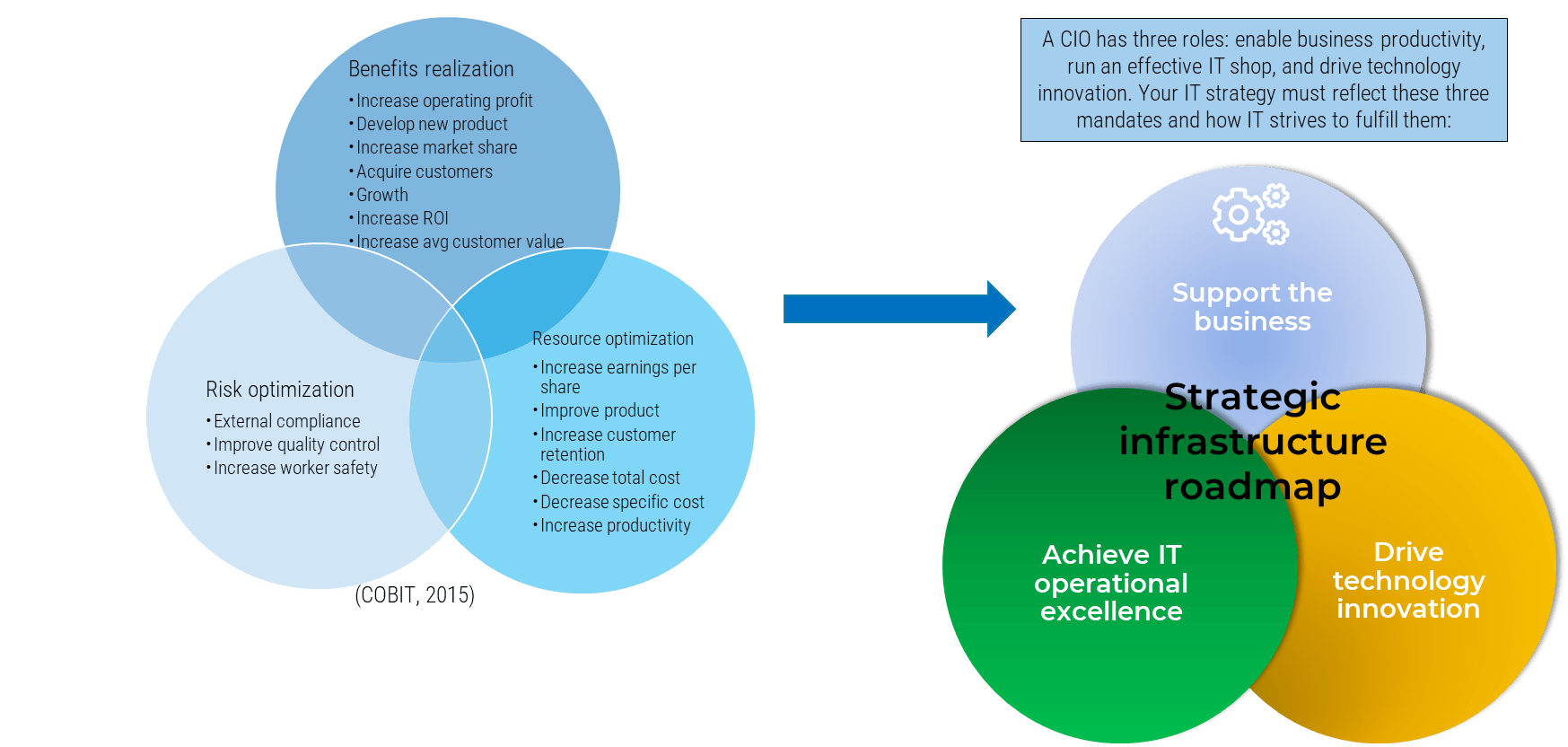
(Info-Tech, Build a Business-Aligned IT Strategy 2022)
1.2.4 Goal association exercise and analysis
1 hour
Wherever possible use the language of your customers to avoid confusion, but at least ensure that everyone in infrastructure is using a common language.
- Take your business strategy or IT strategy or survey response (Activity 1.2.3) or Info-Tech's fundamental goals list (strategic agility, improved cash flow, innovate product, safety, standardize end-user experience) and write them across the top of a whiteboard.
- Have everyone write, on a sticky note, their current in-flight initiatives – one per sticky note.
- Have each participant then place each of their sticky notes on the whiteboard and draw a line from the initiative to the goal it supports.
- The rest of the group should challenge any relationships that seem unsupported or questionable.
Discussion:
- How many goals are you supporting? Are there too many? Are you doing enough to support the right goals?
- Is there a shared understanding of the business goals among the infrastructure staff? Or, do questions about meaning keep coming up?
- Do you have initiatives that are difficult to express in terms of business goals? Do you have a lot of them or just a few?
Input
- Goal list
- In-flight initiatives list
Output
- Initiatives-to-goals map
Materials
- Whiteboard & markers
Participants
- Roadmap team
Summary of Accomplishment
Review performance from last fiscal year.
- Analyzed and communicated the benefits and value realized from IT's strategic initiatives in the past fiscal year.
- Analyzed and prioritized diagnostic data insights to communicate IT success stories.
- Elicited important retrospective information such as KPIs, financials, etc. to build IT's credibility as a strategic business partner.
If you would like additional support, have our analysts guide you through other phases as part of an Info-Tech workshop
Contact your account representative for more information.
workshops@infotech.com 1-888-670-8889
Phase 2
Envision Future and Analyze Constraints
Phase 1 | Phase 2 | Phase 3 | Phase 4 |
|---|---|---|---|
1.1 Infrastructure strategy 1.2 Goal alignment | 2.1 Define your future 2.2 Conduct constraints analysis | 3.1 Drive business alignment 3.2. Build the roadmap | 4.1 Identify the audience 4.2 Process improvement and measurements |
This phase will walk you through the following activities:
- Determine from a greenfield perspective what the future state looks like.
- Do SWOT analysis on technology you may plan to use in the future.
- Complete a time study.
This phase involves the following participants:
- Roadmap team
Step 2.1
Define the future state
Activities
2.1.1 Define your future infrastructure vision
2.1.2 Document desired future state
2.1.3 Develop a new technology identification process
2.1.4 Conduct a SWOT analysis
This step requires the following inputs:
- Emerging technology interest
This step involves the following participants:
- Roadmap team
- External SMEs
Outcomes of this step
- Technology discovery process
- Technology assessment process
- Future state vision document
Future state discussion
"Very few of us are lucky enough to be one of the first few employees in a new organization. Those of you who get to plan the infrastructure with a blank slate and can focus all of your efforts on doing things right the first time."
BMC, 2018
"A company's future state is ultimately defined as the greater vision for the business. It's where you want to be, your long-term goal in terms of the ever-changing state of technology and how that applies to your present-day business."
"Without a definitive future state, a company will often find themselves lacking direction, making it harder to make pivotal decisions, causing misalignment amongst executives, and ultimately hindering the progression and growth of a company's mission."
Source: Third Stage Consulting
"When working with digital technologies, it is imperative to consider how such technologies can enhance the solution. The future state should communicate the vision of how digital technologies will enhance the solutions, deliver value, and enable further development toward even greater value creation."
Source: F. Milani
Info-Tech Insight
Define your infrastructure roadmap as if you had a blank slate – no constraints, no technical debt, and no financial limitations. Imagine your future infrastructure and let that vision drive your roadmap.
Expertise is not innate; it requires effort and research
Evaluating new enterprise technology is a process of defining it, analyzing it, and sourcing it.
- Understand what a technology is in order to have a common frame of reference for discussion. Just as important, understand what it is not.
- Conduct an internal and external analysis of the technology including an adoption case study.
- Provide an overview of the vendor landscape, identifying the leading players in the market and how they differentiate their offerings.
This is not intended to be a thesis grade research project, nor an onerous duty. Most infrastructure practitioners came to the field because of an innate excitement about technology! Harness that excitement and give them four to eight hours to indulge themselves.
An output of approximately four slides per technology candidate should be sufficient to decided if moving to PoC or pilot is warranted.
Including this material in the roadmap helps you control the technology conversation with your audience.
Info-Tech Best Practices
Don't start from scratch. Recall the original sources from your technology watchlist. Leverage vendors and analyst firms (such as Info-Tech) to give the broad context, letting you focus instead on the specifics relevant to your business.
Channel emerging technologies to ensure the rising tide floats all boats rather than capsizing your business
Adopting the wrong new technology can be even more dangerous than failing to adopt any new technology.
Implementing every new promising technology would cost prodigious amounts of money and time. Know the costs before choosing what to invest in.
The risk of a new technology failing is acceptable. The risk of that failure disrupting adjacent core functions is unacceptable. Vet potential technologies to ensure they can be safely integrated.
Best practices for new technologies are nonexistent, standards are in flux, and use cases are fuzzy. Be aware of the unforeseen that will negatively affect your chances of a successful implementation.
"Like early pioneers crossing the American plains, first movers have to create their own wagon trails, but later movers can follow in the ruts."
Harper Business, 2014
Info-Tech Insight
The right technology for someone else can easily be the wrong technology for your business.
Even with a mature Enterprise Architecture practice, wrong technology bets can happen. Minimize the chance of this occurrence by making selection an infrastructure-wide activity. Leverage the practical knowledge of the day-to-day operators.
First Mover |
47% failure rate |
Fast Follower |
8% failure rate |
2.1.1 Create your future infrastructure vision
1 hour
Objective: Help teams define their future infrastructure state (assuming zero constraints or limitations).
- Ask each participant to ponder the question: "How would the infrastructure look if there were no limitations?" They should consider all aspects of their infrastructure but keep in mind the infrastructure vision and mission statements from phase one, as well as the business goals.
- Have each participant write down their ideas on sticky notes – one per note.
- Select a moderator and a scribe from the group – not the infrastructure leader or the CIO. The moderator will begin by placing (and explaining) their sticky notes on the whiteboard. The scribe will summarize the results in short statements at the end.
- Have each participant place and explain their sticky notes on the whiteboard.
- The moderator will assist each participant in grouping sticky notes together based on theme.
- Once everyone has placed their sticky notes and groups have been arranged and rearranged, you should have a visual representation of infrastructure's understanding of the business' priorities.
- Let the infrastructure leader and/or CIO place their sticky notes last.
Discussion:
- Assume a blank slate as a starting point. No technical debt or financial constraints; nothing holding you back.
- Can SaaS, PaaS, or other cloud-based offerings play a role in this future utopia?
- Do vendors play a larger or smaller role in your future infrastructure vision?
Download the IT Infrastructure Strategy and Roadmap Report Template and document your mission and vision statements in Section 1.
Input
- Thoughts and ideas about how the future infrastructure should look.
Output
- Future state vision
Materials
- Sticky notes
- Whiteboard & markers
Participants
- Roadmap team
2.1.1 Document your future state vision (cont'd)
Objective: Help teams define their future infrastructure state (assuming zero constraints or limitations).
1 hour
Steps:
- The scribe will take the groups of suggestions and summarize them in a statement or two, briefly describing the infrastructure in that group.
- The statements should be recorded on Tab 2 of the Infrastructure Strategy and Roadmap Tool.
Discussion:
- Should the points be listed in any specific order?
- Include all suggestions in the summary. Remember this is a blank slate with no constraints, and no idea is higher or lower in weight at this stage.
| Infrastructure Future State Vision | ||
|---|---|---|
| Item | Focus Area | Future Vision |
| 1 | Residing on Microsoft 365 | |
| 2 | Servers | Hosted in cloud - nothing on prem. |
| 3 | Endpoints | virtual desktops on Microsoft Azure |
| 4 | Endpoint hardware | Chromebooks |
| 5 | Network | internet only |
| 6 | Backups | cloud based but stored in multiple cloud services |
| 7 | ||
Download Info-Tech's Infrastructure Strategy and Roadmap Tool and document your future state vision in the Infrastructure Future State tab.
Input
- Thoughts and ideas about how the future infrastructure should look.
Output
- Future state vision
Materials
- Sticky notes
- Whiteboard & markers
Participants
- Roadmap team
2.1.2 Identification and association exercise
1 hour
Formalize what is likely an ad hoc process.
- Brainstorm with the group a list of external sources they are currently using to stay abreast of the market.
- Organize this list on the left-hand side of a whiteboard, in vendor and vendor-neutral groups.
- For each item in the list ask a series of questions:
- Is this a push or pull source?
- Is this source suited to individual or group consumption?
- What is the frequency of this source?
- What is the cost of this source to the company?
- On the right-hand side of the whiteboard brainstorm a list of internal mechanisms for sharing new technology information. Ask about the audience, distribution mode, and frequency for each of those mechanisms.
- Map which of the external sources make it over to internal distribution.
Discussion:
- Are we getting the most value out of our high-cost conferences? Does that information make it from the attendees to the rest of the team?
- Do we share information only within our domains? Or across the whole infrastructure practice?
- Do we have sufficient diversity of sources? Are we in danger of believing one vendor's particular market interpretation?
- How do we select new technologies to explore further? Make it fun – upvotes, for example.
Input
- Team knowledge
- Conference notes
- Expense reports
Output
- Internal socialization process
- Tech briefings & repository
Materials
- Whiteboard & markers
Participants
- Roadmap team
Info-Tech Best Practices
It is impractical for everyone to present their tech briefing at the monthly meeting. But you want to avoid a one-to-many exercise. Keep the presenter a secret until called on. Those who do not present live can still contribute their material to the technology watchlist database.
Analyze new technologies for your future state
Four to eight hours of research per technology can uncover a wealth of relevant information and prepare the infrastructure team for a robust discussion. Key research elements include:
- Précis: A single page or slide that describes the technology, outlines some of the vendors, and explores the value proposition.
- SWOT Analysis:
- Strengths and weaknesses: What does the technology inherently do well (e.g. lots of features) and what does it do poorly (e.g. steep learning curve)?
- Opportunities and threats: What capabilities can the technology enable (e.g. build PCs faster, remote sensing)? Why would we not want to exploit this technology (e.g. market volatility, M&As)
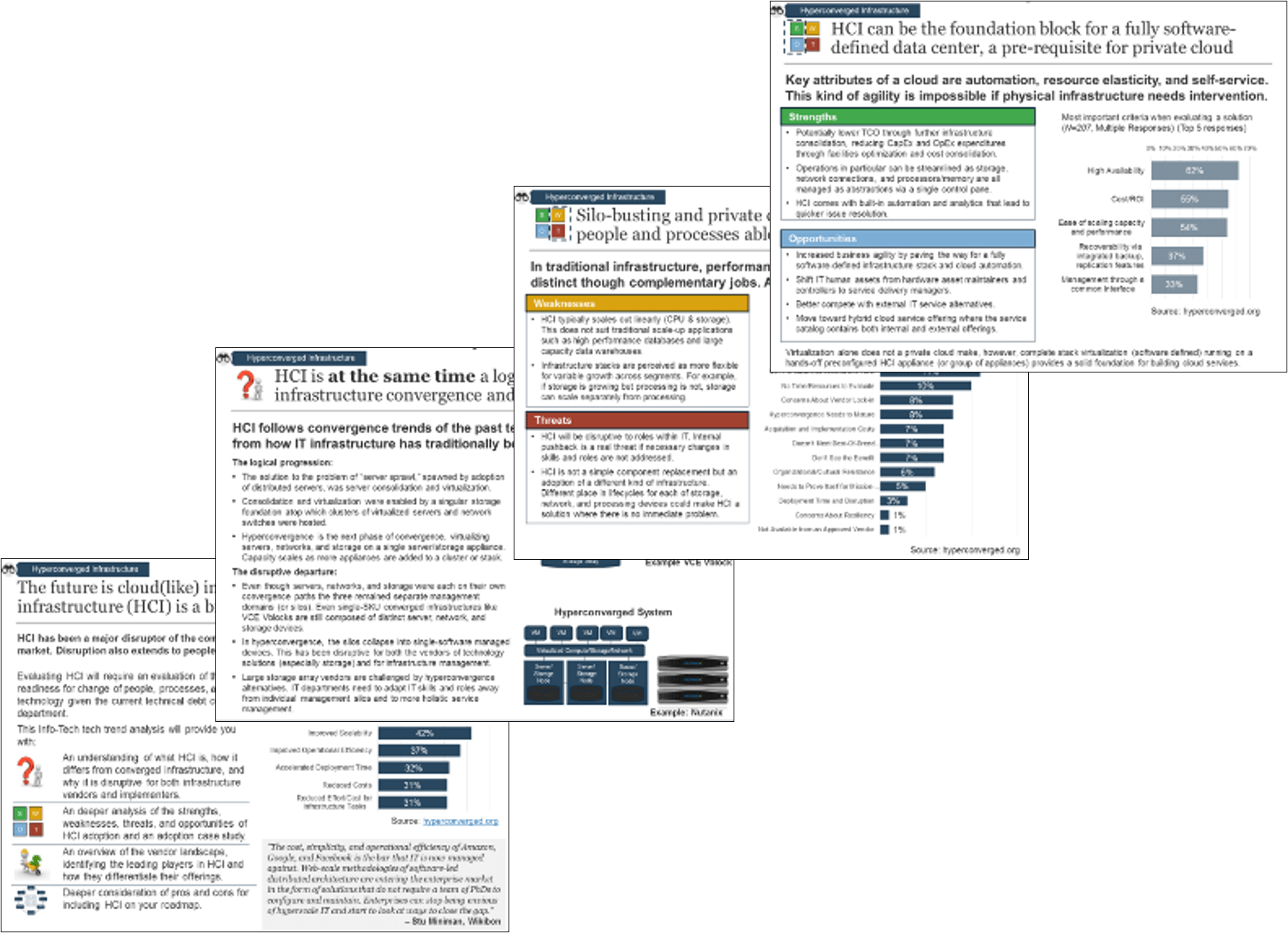
Download the IT Infrastructure Strategy and Roadmap Report Template slides 21, 22, 23 for sample output.
Position infrastructure as the go-to source for information about new technology
One way or another, tech always seems to finds its way into infrastructure's lap. Better to stay in front and act as stewards rather than cleanup crew.
Beware airline magazine syndrome! |
Symptoms |
Pathology |
|---|---|---|
|
Outbreaks tend to occur in close proximity to
|
Effective treatment options
- Targeted regular communication with a technology portfolio analysis customized to the specific goals of the business.
- Ongoing PoC and piloting efforts with detailed results reporting.
While no permanent cure exists, regular treatment makes this chronic syndrome manageable.
Keep your roadmap horizon in mind
Technology doesn't have to be bleeding edge. New-to-you can have plenty of value.
You want to present a curated landscape of technologies, demonstrating that you are actively maintaining expertise in your chosen field.
Most enterprise IT shops buy rather than develop their technology, which means they want to focus effort on what is market available. The outcome is that infrastructure sponsors and delivers new technologies whose capabilities and features will help the business achieve its goals on this roadmap.
If you want to think more like a business disruptor or innovator, we suggest working through the blueprint Exploit Disruptive Infrastructure Technology.
Explore technology five to ten years into the future!
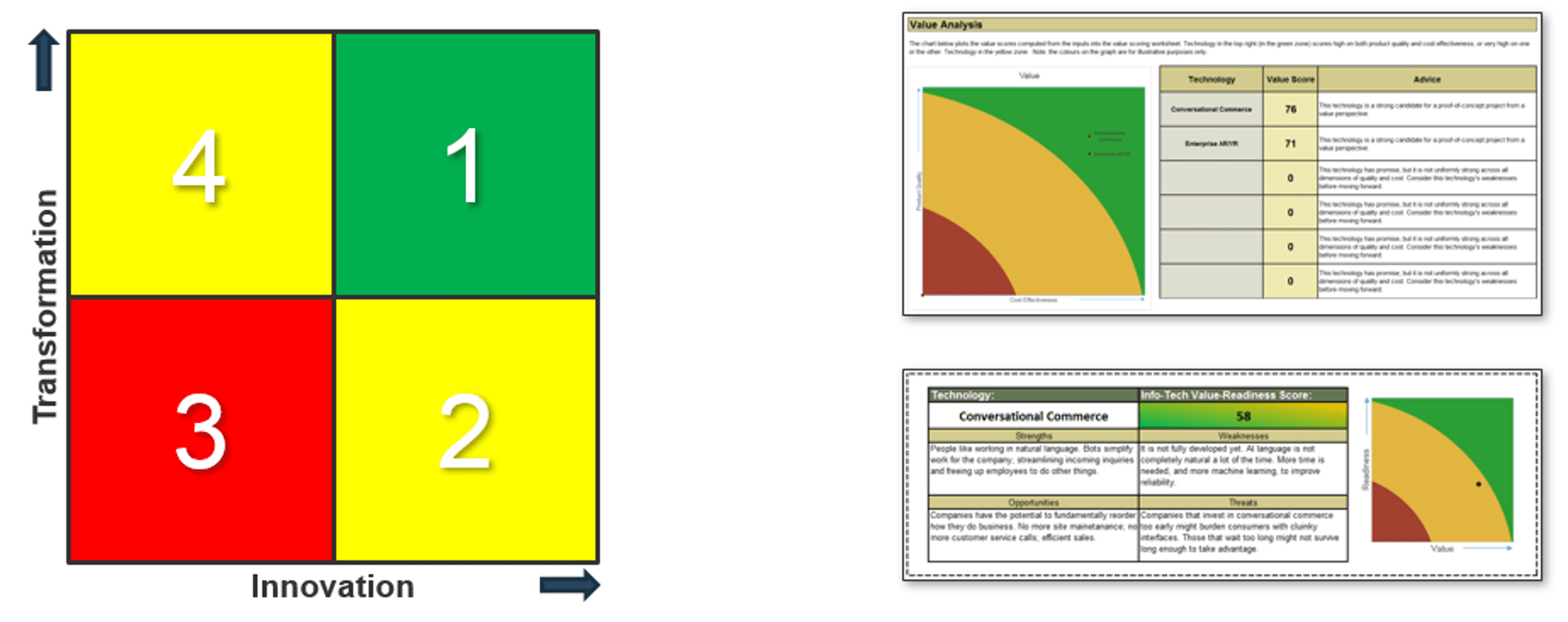
Info-Tech Insight
The ROI of any individual effort is difficult to justify – in aggregate, however, the enterprise always wins!
Money spent on Google Glass in 2013 seemed like vanity. Certainly, this wasn't enterprise-ready technology. But those early experiences positioned some visionary firms to quickly take advantage of augmented reality in 2018. Creative research tends to pay off in unexpected and unpredictable ways.
.
2.1.3 Working session, presentation, and feedback
1 hour
Complete a SWOT analysis with future state technology.
The best research hasn't been done in isolation since the days of da Vinci.
- Divide the participants into small groups of at least four people.
- Further split those groups into two teams – the red team and the white team.
- Assign a technology candidate from the last exercise to each group. Ideally the group should have some initial familiarity with the technology and/or space.
- The red team from each group will focus on the weaknesses and threats of the technology. The white team will focus on the strengths and opportunities of the technology.
- Set a timer and spend the next 30-40 minutes completing the SWOT analysis.
- Have each group present their analysis to the larger team. Encourage conversation and debate. Capture and refine the understanding of the analysis.
- Reset with the next technology candidate. Have the participants switch teams within their groups.
- Continue until you've exhausted your technology candidates.
Discussion:
- Does working in a group make for better research? Why?
- Do you need specific expertise in order to evaluate a technology? Is an outsider (non-expert) view sometimes valuable?
- Is it easier to think of the positive or the negative qualities of a technology? What about the internal or external implications?
Input
- Technology candidates
Output
- Technology analysis including SWOT
Materials
- Projector
- Templates
- Laptops & internet
Participants
- Roadmap team
Step 2.2
Constraints analysis
Activities
2.2.1 Historical spend analysis
2.2.2 Conduct a time study
2.2.3 Identify roadblocks
This step requires the following inputs:
- Historical spend and staff numbers
- Organizational design identification and thought experiment
- Time study
- Roadblock brainstorming session
- Prioritization exercise
This step involves the following participants:
- Financial leader
- HR Leader
- Roadmap team
Outcomes of this step
- OpEx, CapEx, and staffing trends
- Domain time study
- Prioritized roadblock list
2.2.1 Historical spend analysis
"A Budget is telling your money where to go, instead of wondering where it went."
-David Ramsay
"Don't tell me where your priorities are. Show me where you spend your money and I'll tell you what they are"
-James Frick, Due.com
| Annual IT budgeting aligns with business goals | |
 |
50% of businesses surveyed see that improvements are necessary for IT budgets to align to business goals, while 18% feel they require significant improvements to align to business goals |
Challenges in IT spend visibility |
|
 |
Visibility of all spend data for on-prem, SaaS and cloud environments |
The challenges that keep IT leaders up at night |
|
 |
Lack of visibility in resource usage and cost |
2.2.1 Build a picture of your financial spending and staffing trends
Follow the steps below to generate a visualization so you can start the conversation:
1 hour
- Open the Info-Tech Infrastructure Roadmap Financial Spend Analysis Tool.
- The Instructions tab will provide guidance, or you can follow the instructions below.
- Insert values into the appropriate uncolored blocks in the first 4 rows of the Spend Record Entry tab to reflect the amount spent on IT OpEx, IT CapEx, or staff numbers for the present year (budgeted) as well as the previous five years.
- Data input populates cells in subsequent rows to quickly reveal spending ratios.

Download the Infrastructure Roadmap Financial Analysis Tool
( additional Deep Dive available if required)
Input
- Historical spend and staff numbers
Output
- OpEx, CapEx, and staffing trends for your organization
Materials
- Info-Tech's Infrastructure Roadmap Financial Spend Analysis Tool
Participants
- Infrastructure leader
- Financial leader
- HR leader
2.2.1 Build a picture of your financial spending and staffing trends (cont'd)
Continue with the steps below to generate a visualization so you can start the conversation.
1 hour
- Select tab 3 (Results) to reveal a graphical analysis of your data.
- Trends are shown in graphs for OpEx, CapEx, and staffing levels as well as comparative graphs to show broader trends between multiple spend and staffing areas.
- Some observations worth noting may include the following:
- Is OpEx spending increasing over time or decreasing?
- Is CapEx increasing or decreasing?
- Are OpEx and CapEx moving in the same directions?
- Are IT staff to total staff ratios increasing or decreasing?
- Trends will continue in the same direction unless changes are made.
Download the Infrastructure Roadmap Financial Analysis Tool
( additional Deep Dive available if required)
Input
- Historical spend and staff numbers
Output
- OpEx, CapEx, and staffing trends for your organization
Materials
- Info-Tech's Infrastructure Roadmap Financial Spend Analysis Tool
Participants
- Infrastructure leader
- Financial leader
- HR leader
Consider perceptions held by the enterprise when dividing infrastructure into domains
2.2.2 Conduct a time study
Internal divisions that seem important to infrastructure may have little or even negative value when it comes to users accessing their services.
Domains are the logical divisions of work within an infrastructure practice. Historically, the organization was based around physical assets: servers, storage, networking, and end-user devices. Staff had skills they applied according to specific best practices using physical objects that provided functionality (computing power, persistence, connectivity, and interface).
Modern enterprises may find it more effective to divide according to activity (analytics, programming, operations, and security) or function (customer relations, learning platform, content management, and core IT). As a rule, look to your organizational chart; managers responsible for buying, building, deploying, or supporting technologies should each be responsible for their own domain.
Regardless of structure, poor organization leads to silos of marginally interoperable efforts working against each other, without focus on a common goal. Clearly defined domains ensure responsibility and allow for rapid, accurate, and confident decision making.
- Server
- Network
- Storage
- End User
- DevOps
- Analytics
- Core IT
- Security
Info-Tech Insight
The medium is the message. Do stakeholders talk about switches or storage or services? Organizing infrastructure to match its external perception can increase communication effectiveness and improve alignment.
Case Study
IT infrastructure that makes employees happier
INDUSTRY: Services
SOURCE: Network Doctor
Challenge
Atlas Electric's IT infrastructure was very old and urgently needed to be refreshed. Its existing server hardware was about nine years old and was becoming unstable. The server was running Windows 2008 R2 server operating systems that was no longer supported by Microsoft; security updates and patches were no longer available. They also experienced slowdowns on many older PCs.
Recommendations for an upgrade were not approved due to budgetary constraints. Recommendations for upgrading to virtual servers were approved following a harmful phishing attack.
Solution
The following improvements to their infrastructure were implemented.
- Installing a new physical host server running VMWare ESXi virtualization software and hosting four virtual servers.
- Migration of data and applications to new virtual servers.
- Upgrading networking equipment and deploying new relays, switches, battery backups, and network management.
- New server racks to host new hardware.
Results
Virtualization, consolidating servers, and desktops have made assets more flexible and simpler to manage.
Improved levels of efficiency, reliability, and productivity.
Enhanced security level.
An upgraded backup and disaster recovery system has improved risk management.
Optimize where you spend your time by doing a time study
Infrastructure activity is limited generally by only two variables: money and time. Money is in the hands of the CFO, which leaves us a single variable to optimize.
Not all time is spent equally, nor is it equally valuable. Analysis lets us communicate with others and gives us a shared framework to decide where our priorities lie.
There are lots of frameworks to help categorize our activities. Stephen Covey (Seven Habits of Highly Effective People) describes a four-quadrant system along the axes of importance and urgency. Gene Kim, through his character Erik in The Phoenix Project,speaks instead of business projects, internal IT projects, changes, and unplanned work.
We propose a similar four-category system.
| Project | Maintenance | Administrative |
Reactive |
|---|---|---|---|
Planned activity spent pursuing a business objective |
Planned activity spent on the upkeep of existing IT systems |
Planned activity required as a condition of employment |
Unplanned activity requiring immediate response |
This is why we are valuable to our company |
We have it in our power to work to reduce these three in order to maximize our time available for projects |
||
Survey and analysis
Perform a quick time study.
Verifiable data sources are always preferred but large groups can hold each other's inherent biases in check to get a reasonable estimate.
1 hour
- Organize the participants into the domain groups established earlier.
- On an index card have each participant independently write down the percentage of time they think their entire domain (not themselves personally) spends during the average month, quarter, or year on:
- Admin
- Reactive work
- Maintenance
- Draw a matrix on the whiteboard; collect the index cards and transcribe the results from participants into the matrix.
- Add up the three reported time estimates and subtract from 100 – the result is the percentage of time available for/spent on project work.
Discussion
- Certain domains should have higher percentages of reactive work (think Service Desk and Network Operations Center) – can we shift work around to optimize resources?
- Why is reactive work the least desirable type? Could we reduce our reactive work by increasing our maintenance work?
- From a planning perspective, what are the implications of only having x% of time available for project work?
- Does it feel like backing into the project work from adding the other three together provides a reasonable assessment?
Input
- Domain groups
Output
- Time study
Materials
- Whiteboard & markers
- Index cards
Participants
- Roadmap team
Quickly and easily evaluate all your infrastructure
Strategic Infrastructure Roadmap Tool, Tab 2, Capacity Analysis
In order to quickly and easily build some visualizations for the eventual final report, Info-Tech has developed the Strategic Infrastructure Roadmap Tool.
- Up to five infrastructure domains are supported.
- For practices that cannot be reasonably collapsed into five domains, multiple copies of the tool can be used and manually stitched together.
- The tool can be used in either an absolute (total number) or relative mode (percentage of available).
- By design we specifically don't ask for a project work figure but rather calculate it based on other values.
- For everything but miscellaneous duties, hard data sources can (and where appropriate should) be leveraged.
- Reactive work – service desk tool
- Project work – project management tool
- Maintenance work – logs or ITSM tool
- Individual domains' values are calculated, as well as the overall breakdown for the infrastructure practice.
- Even these rough estimates will be useful during the planning steps throughout the rest of the roadmap process.
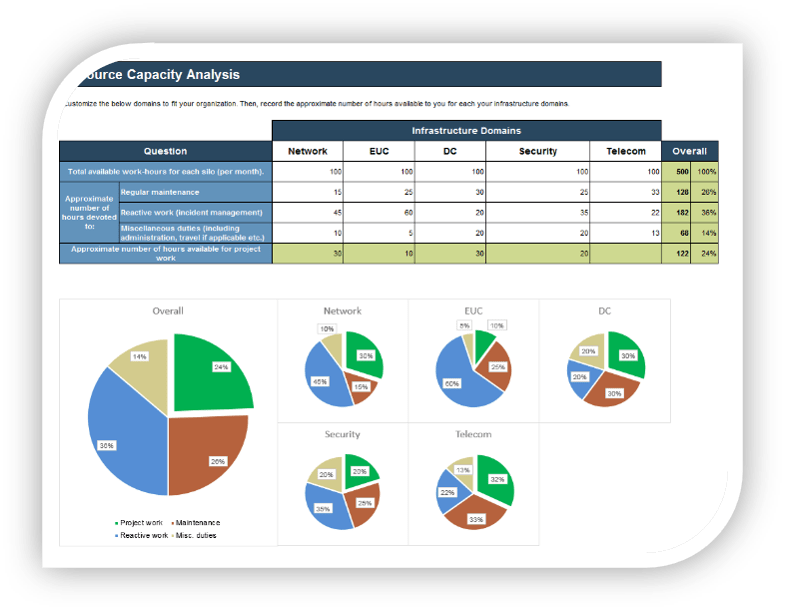
Please note that this tool requires Microsoft's Power Pivot add-in to be installed if you are using Excel 2010 or 2013. The scatter plot labels on tabs 5 and 8 may not function correctly in Excel 2010.
Build your roadmap from both the top and the bottom for best results
Strong IT strategy favors top-down: activities enabling clearly dictated goals. The bottom-up approach aggregates ongoing activities into goals.
Systematic approach
External stakeholders prioritize a list of goals requiring IT initiatives to achieve.
Roadblocks:
- Multitudes of goals easily overwhelm scant IT resources.
- Unglamorous yet vital maintenance activities get overlooked.
- Goals are set without awareness of IT capacity or capabilities.
Organic approach
Practitioners aggregate initiatives into logical groups and seek to align them to one or more business goals.
Roadblocks:
- Pet initiatives can be perpetuated based on cult of personality rather than alignment to business goals.
- Funding requests can fall flat when competing against other business units for executive support.
A successful roadmap respects both approaches.
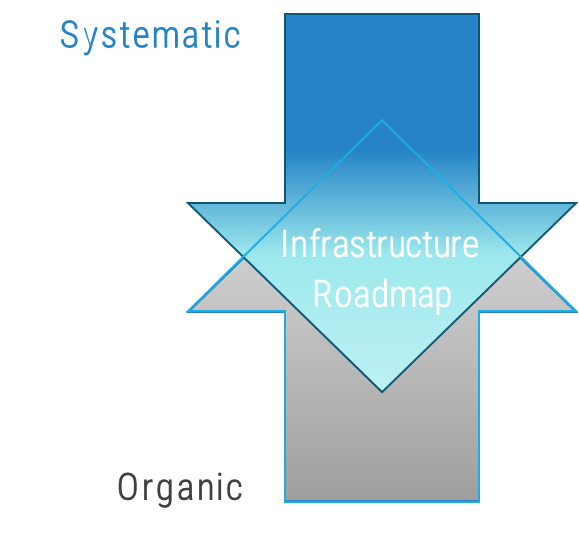
Info-Tech Insight
Perfection is anathema to practicality. Draw the first picture and not only expect but welcome conflicting feedback! Socialize it and drive the conversation forward to a consensus.
2.2.3 Brainstorming – Affinity diagramming
Identify the systemic roadblocks to executing infrastructure projects
1 hour
Affinity diagramming is a form of structured brainstorming that works well with larger groups and provokes discussion.
- Have each participant write down their top five impediments to executing their projects from last year – one roadblock per sticky note.
- Once everyone has written their top five, select a moderator from the group. The moderator will begin by placing (and explaining) their five sticky notes on the whiteboard.
- Have each participant then place and explain their sticky notes on the whiteboard.
- The moderator will assist participants in grouping sticky notes together based on theme.
- Groups that have become overly large may be broken into smaller, more precise themes.
- Once everyone has placed their sticky notes, you should be able to visually identify the greatest or most common roadblocks the group perceives.
Discussion
Categorize each roadblock identified as either internal or external to infrastructure's control.
Attempt to understand the root cause of each roadblock. What would you need to ask for in order to remove the roadblock?
Additional Research
Also called the KJ Method (after its inventor, Jiro Kawakita, a 1960s Japanese anthropologist), this activity helps organize large amounts of data into groupings based on natural relationships while reducing many social biases.
Input
- Last years initiatives and their roadblocks
Output
- List of refined Roadblocks
Materials
- Sticky notes
- Whiteboard & markers
Participants
- Roadmap team
2.2.4 Prioritization exercise – Card sorting
Choose your priorities wisely.
Which roadblocks do you need to work on? How do you establish a group sense of these priorities? This exercise helps establish priorities while reducing individual bias.
1 hour
- Distribute index cards that have been prepopulated with the roadblocks identified in the previous activity – one full set of cards to each participant.
- Have each participant sort their set-in order of perceived priority, highest on top.
- Where n=number of cards in the stack, take the n-3 lowest priority cards and put a tick mark in the upper-right-hand corner. Pass these cards to the person on the left, who should incorporate them into their pile (if you start with eight cards you're ticking and passing five cards). Variation: On the first pass, allow everyone to take the most important and least important cards, write "0th" and "NIL" on them, respectively, and set them aside.
- Repeat steps 2 and 3 for a total of n times. Treat duplicates as a single card in your hand.
- After the final pass, ask each participant to write the priority in the upper-left-hand corner of their top three cards.
- Collect all the cards, group by roadblock, count the number of ticks, and take note of the final priority.
Discussion
Total the number of passes (ticks) for each roadblock. A large number indicates a notionally low priority. No passes indicates a high priority.
Are the internal or external roadblocks of highest priority? Were there similarities among participants' 0th and NILs compared to each other or to the final results?
Input
- Roadblock list
Output
- Prioritized roadblocks
Materials
- Index cards
Participants
- Roadmap team
Summary of Accomplishment
Review performance from last fiscal year
- Analyzed and communicated the benefits and value realized from IT's strategic initiatives in the past fiscal year.
- Analyzed and prioritized diagnostic data insights to communicate IT success stories.
- Elicited important retrospective information such as KPIs, financials, etc. to build IT's credibility as a strategic business partner.
If you would like additional support, have our analysts guide you through other phases as part of an Info-Tech workshop
Contact your account representative for more information.
workshops@infotech.com 1-888-670-8889
Phase 3
Align and Build the Roadmap
Phase 1 | Phase 2 | Phase 3 | Phase 4 |
|---|---|---|---|
1.1 Infrastructure strategy 1.2 Goal alignment | 2.1 Define your future 2.2 Conduct constraints analysis | 3.1 Drive business alignment 3.2. Build the roadmap | 4.1 Identify the audience 4.2 Process improvement and measurements |
This phase will walk you through the following activities:
- Elicit business context from the CIO & IT team
- Identify key initiatives that support the business
- Identify key initiatives that enable IT excellence
- Identify initiatives that drive technology innovation
- Build initiative profiles
- Construct your strategy roadmap
This phase involves the following participants:
- Roadmap Team
Step 3.1
Drive business alignment
Activities
3.1.1 Develop a risk framework
3.1.2 Evaluate technical debt
This step requires the following inputs:
- Intake identification and analysis
- Survey results analysis
- Goal brainstorming
- Goal association and analysis
This step involves the following participants:
- Business leadership
- Project Management Office
- Service Desk
- Business Relationship Management
- Solution or Enterprise Architecture
- Roadmap team
Outcomes of this step
- Intake analysis
- Goal list
- Initiative-to-goal map
Speak for those with no voice – regularly review your existing portfolio of IT assets and services
A chain is only as strong as its weakest link; while you'll receive no accolades for keeping the lights on, you'll certainly hear about it if you don't!
Time has been a traditional method for assessing the fitness of infrastructure assets – servers are replaced every five years, core switches every seven, laptops and desktops every three. While quick, this framework of assessment is overly simplistic for most modern organizations.
Building one that is instead based on the likelihood of asset failure plotted against the business impact of that failure is not overly burdensome and yields more practical results. Infrastructure focuses on its strength (assessing IT risk) and validates an understanding with the business regarding the criticality of the service(s) enabled by any given asset.
Rather than fight on every asset individually, agree on a framework with the business that enables data-driven decision making.
IT Risk Factors
Age, Reliability, Serviceability, Conformity, Skill Set
Business Risk Factors
Suitability, Capacity, Safety, Criticality
Info-Tech Insight
Infrastructure in a cloud-enabled world: As infrastructure operations evolve it is important to keep current with the definition of an asset. Software platforms such as hypervisors and server OS are just as much an asset under the care and control of infrastructure as are cloud services, managed services from third-party providers, and traditional racks and switches.
3.1.1 Develop a risk framework – Classification exercise
While it's not necessary for each infrastructure domain to view IT risk identically, any differences should be intensely scrutinized.
1 hour
- Divide the whiteboard along the axes of IT Risk and
Business Risk (criticality) into quadrants:- High IT Risk & High Biz Risk (upper right)
- Low IT Risk & Low Biz Risk (bottom left)
- Low IT Risk & High Biz Risk (bottom right)
- High IT Risk & Low Biz Risk (upper left)
- Have each participant write the names of two or three infrastructure assets or services they are responsible or accountable for – one name per sticky note.
- Have each participant come one-at-a-time and place their sticky notes in one quadrant.
- As each additional sticky note is placed, verify with the group that the relative positioning of the others is still accurate.
Discussion:
- Most assets should end up in the lower-right quadrant, indicating that IT has lowered the risk of failure commensurate to the business consequences of a failure. What does this imply about assets in the other three quadrants?
- Infrastructure is foundational; do we properly document and communicate all dependencies for business-critical services?
- What actions can infrastructure take to adjust the risk profile of any given asset?
Input
- List of infrastructure assets
Output
- Notional risk analysis
Materials
- Whiteboard & markers
- Sticky notes
Participants
- Roadmap team
3.1.2 Brainstorming and prioritization exercise
Identify the key elements that make up risk in order to refine your framework.
A shared notional understanding is good, but in order to bring the business onside a documented defensible framework is better.
1 hour
- Brainstorm (possibly using the affinity diagramming technique) the component elements of IT risk.
- Ensure you have a non-overlapping set of risk elements. Ensure that all the participants are comfortable with the definitions of each element. Write them on a whiteboard.
- Give each participant an equal number (three to five) of voting dots.
- As a group have the participants go the whiteboard and use their dots to cast their votes for what they consider to be the most important risk element(s). Participants are free to place any number of their dots on a single element.
- Based on the votes cast select a reasonable number of elements with which to proceed.
- For each element selected, brainstorm up to six tiers of the risk scale. You can use numbers or words, whichever is most compelling.
- E.g. Reliability: no failures, >1 incident per year, >1 incident per quarter, >1 incident per month, frequent issues, unreliable.
- Repeat the above except with the components of business risk. Alternately, rely on existing business risk documentation, possibly from a disaster recovery or business continuity plan.
Discussion
How difficult was it to agree on the definitions of the IT risk elements? What about selecting the scale? What was the voting distribution like? Were there tiers of popular elements or did most of the dots end up on a limited number of elements? What are the implications of having more elements in the analysis?
Input
- Notional risk analysis
Output
- Risk elements
- Scale dimensions
Materials
- Whiteboard & markers
- Voting dots
Participants
- Roadmap team
3.1.3 Forced ranking exercise
Alternate: Identify the key elements that make up risk in order to refine your framework
A shared notional understanding is good, but in order to bring the business onside a documented defensible framework is better.
1 hour
- Brainstorm (possibly using the affinity diagramming technique) the component elements of IT risk.
- Ensure you have a non-overlapping set of risk elements. Ensure that all the participants are comfortable with the definitions of each element. Write them on a whiteboard.
- Distribute index cards (one per participant) with the risk elements written down one side.
- Ask the participants to rank the elements in order of importance, with 1 being the most important.
- Collect the cards and write the ranking results on the whiteboard.
- Look for elements with high variability. Also look for the distribution of 1, 2, and 3 ranks.
- Based on the results select a reasonable number of elements with which to proceed.
- Follow the rest of the procedure from the previous activity.
Discussion:
What was the total number of elements required in order to contain the full set of every participant's first-, second-, and third-ranked risks? Does this seem a reasonable number?
Why did some elements contain both the lowest and highest rankings? Was one (or more) participant thinking consistently different from the rest of the group? Are they seeing something the rest of the group is overlooking?
This technique automatically puts the focus on a smaller number of elements – is this effective? Or is it overly simplistic and reductionist?
Input
- Notional risk analysis
Output
- Risk elements
Materials
- Whiteboard & markers
- Index cards
Participants
- Roadmap team
3.1.4 Consensus weighting
Use your previous notional assessment to inform your risk weightings:
1 hour
- Distribute index cards that have been prepopulated with the risk elements from the previous activity.
- Have the participants independently assign a weighting to each element. The assigned weights must add up to 100.
- Collect the cards and transcribe the results into a matrix on the whiteboard.
- Look for elements with high variability in the responses.
- Discuss and come to a consensus figure for each element's weighting.
- Select a variety of assets and services from the notional assessment exercise. Ensure that you have representation from all four quadrants.
- Using your newly defined risk elements and associated scales, evaluate as a group the values you'd suggest for each asset. Aim for a plurality of opinion rather than full consensus.
- Use Info-Tech's Strategic Infrastructure Roadmap Tool to document the elements, weightings, scales, and asset analysis.
- Compare the output generated by the tool (Tab 4) with the initial notional assessment.
Discussion:
How much framework is too much? Complexity and granularity do not guarantee accuracy. What is the right balance between effort and result?
Does your granular assessment match your notional assessment? Why or why not? Do you need to go back and change weightings? Or reduce complexity?
Is this a more reasonable and valuable way of periodically evaluating your infrastructure?
Input
- Notional risk analysis
Output
- Weighted risk framework
Materials
- Whiteboard & markers
- Index cards
- Strategic Infrastructure Roadmap Tool
Participants
- Roadmap team
3.1.5 Platform assessment set-up
Hard work up front allows for year-over-year comparisons
The value of a risk framework is that once the heavy lifting work of building it is done, the analysis and assessment can proceed very quickly. Once built, the framework can be tweaked as necessary, rather than recreated every year.
- Open Info-Tech's Strategic Infrastructure Roadmap Tool, Tab 3.
- Up to eight elements each of IT and business risk can be captured.
- IT risk elements of end-of-life and dependencies are mandatory and do not count against the eight customizable elements.
- Every element can have up to six scale descriptors. Populate them from left to right in increasing magnitude of risk.
- Scale descriptors must be input as string values and not numeric.
- Each element's scale can be customized from linear to a risk-adverse or risk-seeking curve. We recommend linear.
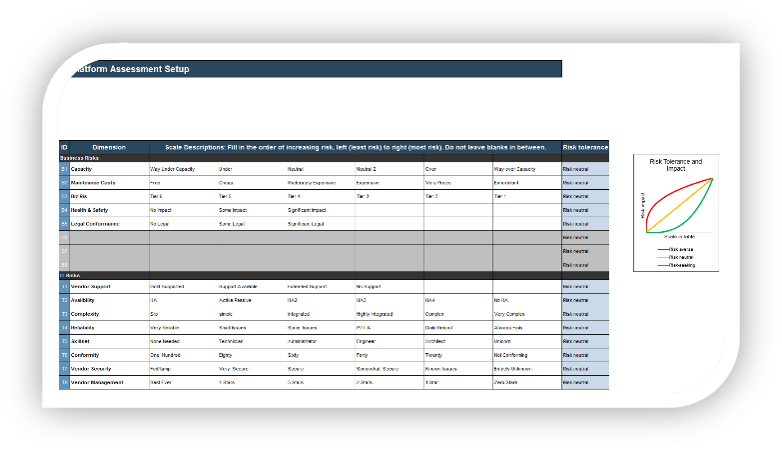
IT platform assessment
Quickly and easily evaluate all your infrastructure.
Once configured, individual domain teams can spend surprisingly little time answering reasonably simple questions to assess their assets. The common framework lets results be compared between teams and produces a valuable visualization to communication with the business.
- Open the Strategic Infrastructure Roadmap Tool, Tab 4.
- The tool has been tested successfully with up to 2,000 asset items. Don't necessarily list every asset; rather, think of the logical groups of assets you'd cycle in or out of your environment.
- Each asset must be associated with one and only one infrastructure domain and have a defined End of Service Life date.
- With extreme numbers of assets an additional filter can be useful – the Grouping field allows you to set any number of additional tags to make sorting and filtering easier.
- Drop-down menus for each risk element are prepopulated with the scale descriptors from Tab 3. Unused elements are greyed out.
- Each asset can be deemed dependent on up to four additional assets or services. Use this to highlight obscure or undervalued relationships between assets. It is generally not useful to be reminded that everything relies on Cat 6 cabling.
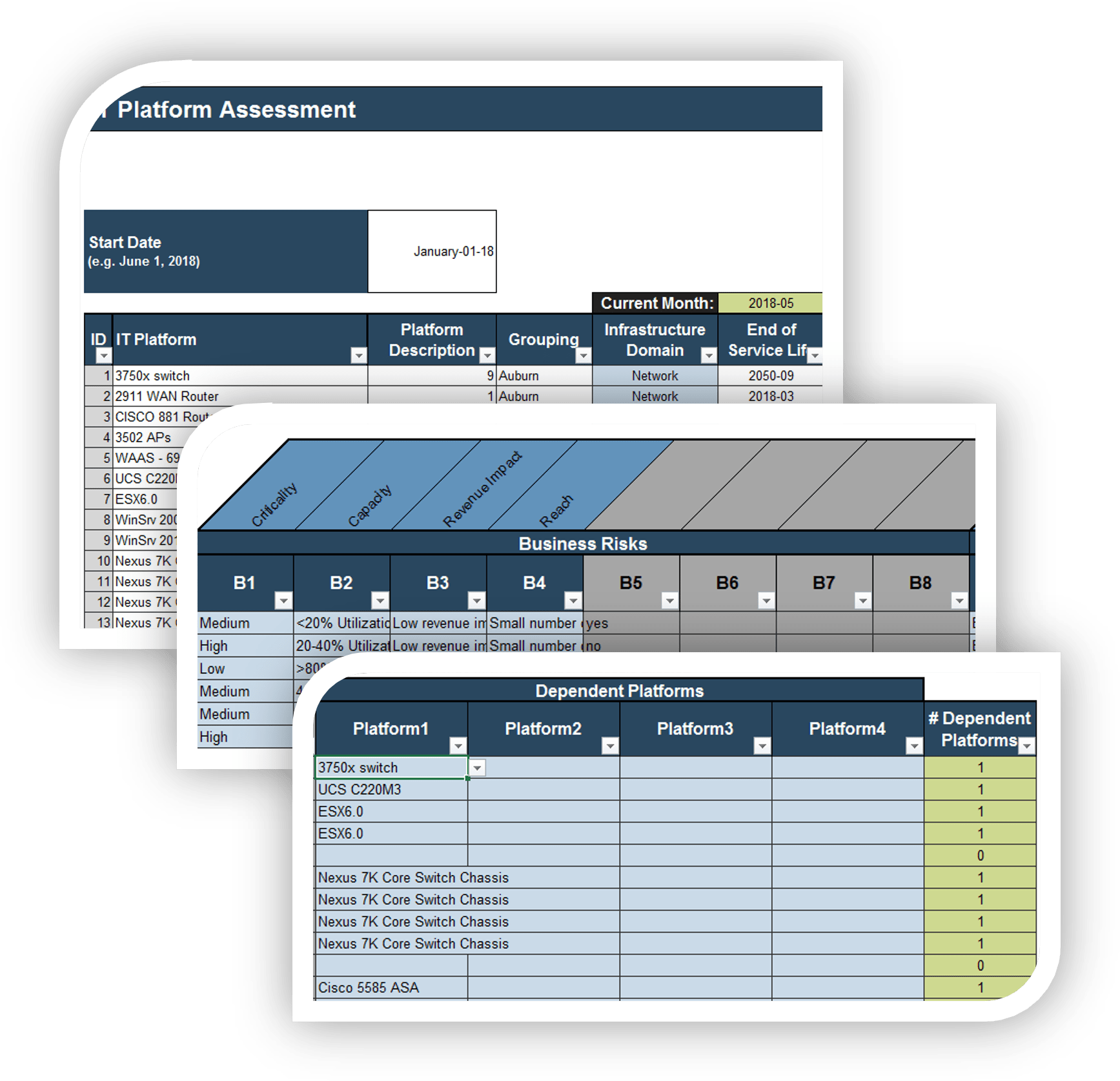
Prioritized upgrades
Validate and tweak your framework with the business
Once the grunt work of inputting all the assets and the associated risk data has been completed, you can tweak the risk profile and sort the data to whatever the business may require.
- Open Info-Tech's Strategic Infrastructure Roadmap Tool, Tab 5.
- IT platforms in the upper-right quadrant have an abundance of IT risk and are critical to the business.
- The visualization can be sorted by selecting the slicers on the left. Sort by:
- Infrastructure domain
- Customized grouping tag
- Top overall risk platforms
- With extreme numbers of assets an additional filter can be useful. The Grouping field allows you to set any number of additional tags to make sorting and filtering easier.
- Risk weightings can be individually adjusted to reflect changing business priorities or shared infrastructure understanding of predictive power.
- In order to make year-over-year comparisons valuable it is recommended that changing IT risk elements should be avoided unless absolutely necessary.
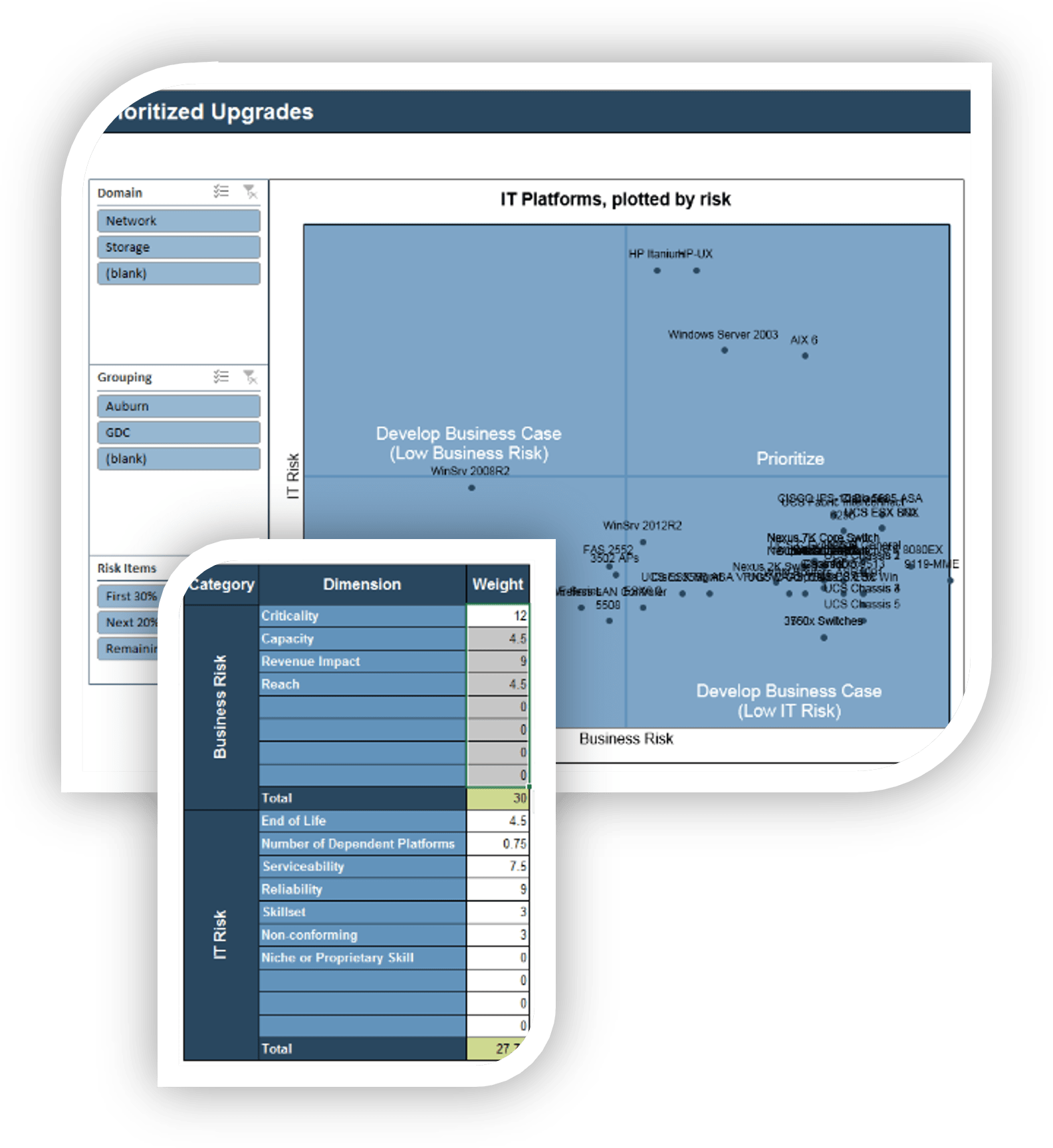
Step 3.2
Build the roadmap
Activities
3.2.1 Build templates and visualize
3.2.2 Generate new initiatives
3.2.3 Repatriate shadow IT initiatives
3.2.4 Finalize initiative candidates
This step requires the following inputs:
- Develop an initiative template
- Restate the existing initiatives with the template
- Visualize the existing initiatives
- Brainstorm new initiatives
- Initiative ranking
- Solicit, evaluate, and refine shadow IT initiatives
- Resource estimation
This step involves the following participants:
- Roadmap team
Outcomes of this step
- Initiative communication template
- Roadmap visualization diagram
Tell them what they really need to know
Templates transform many disparate sources of data into easy-to-produce, easy-to-consume, business-ready documents.
Develop a high-level document that travels with the initiative from inception through executive inquiry and project management, and finally to execution. Understand an initiative's key elements that both IT and the business need defined and that are relatively static over its lifecycle.
Initiatives are the waypoints along a roadmap leading to the eventual destination, each bringing you one step closer. Like steps, initiatives need to be discrete: able to be conceptualized and discussed as a single largely independent item. Each initiative must have two characteristics:
- Specific outcome: Describe an explicit change in the people, processes, or technology of the enterprise.
- Target end date: When the described outcome will be in effect.
"Learn a new skill"– not an effective initiative statement.
"Be proficient in the new skill by the end of the year" – better.
"Use the new skill to complete a project and present it at a conference by Dec 15" – best!
Info-Tech Insight
Bundle your initiatives for clarity and manageability.
Ruthlessly evaluate if an initiative should stand alone or can be rolled up with another. Fewer initiatives increases focus and alignment, allowing for better communication.
3.2.1 Develop impactful templates to sell your initiative upstream
Step 1: Open Info-Tech's Strategic Roadmap Initiative Template. Determine and describe the goals that the initiative is enabling or supporting.
Step 2: State the current pain points from the end-user or business perspective. Do not list IT-specific pain points here, such as management complexity.
Step 3: List both the tangible (quantitative) and ancillary (qualitative) benefits of executing the project. These can be pain relievers derived from the pain points, or any IT-specific benefit not captured in Step 1.
Step 4: List any enabled capability that will come as an output of the project. Avoid technical capabilities like "Application-aware network monitoring." Instead, shoot for business outcomes like "Ability to filter network traffic based on application type."
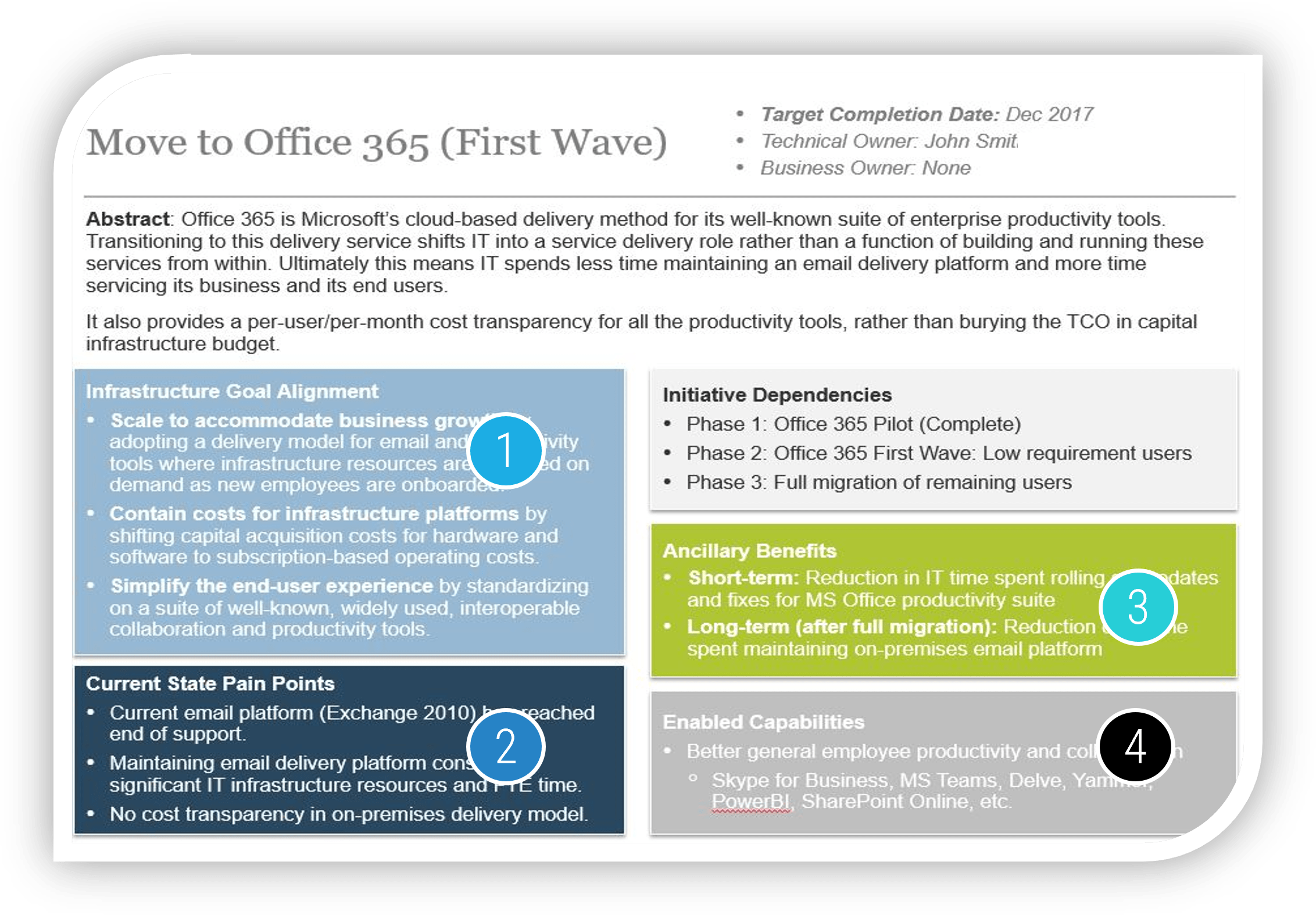
Info-Tech Insight
Sell the project to the mailroom clerk! You need to be able to explain the outcome of the project in terms that non-IT workers can appreciate. This is done by walking as far up the goals cascade as you have defined, which gets to the underlying business outcome that the initiative supports.
Develop impactful templates to sell your initiative upstream (cont'd)
Strategic Roadmap Initiative Template, p. 2
Step 5: State the risks to the business for not executing the project (and avoid restating the pain points).
Step 6: List any known or anticipated roadblocks that may come before, during, or after executing the project. Consider all aspects of people, process, and technology.
Step 7: List any measurable objectives that can be used to gauge the success of the projects. Avoid technical metrics like "number of IOPS." Instead think of business metrics such as "increased orders per hour."
Step 8: The abstract is a short 50-word project description. Best to leave it as the final step after all the other aspects of the project (risks and rewards) have been fully fleshed out. The abstract acts as an executive summary – written last, read first.
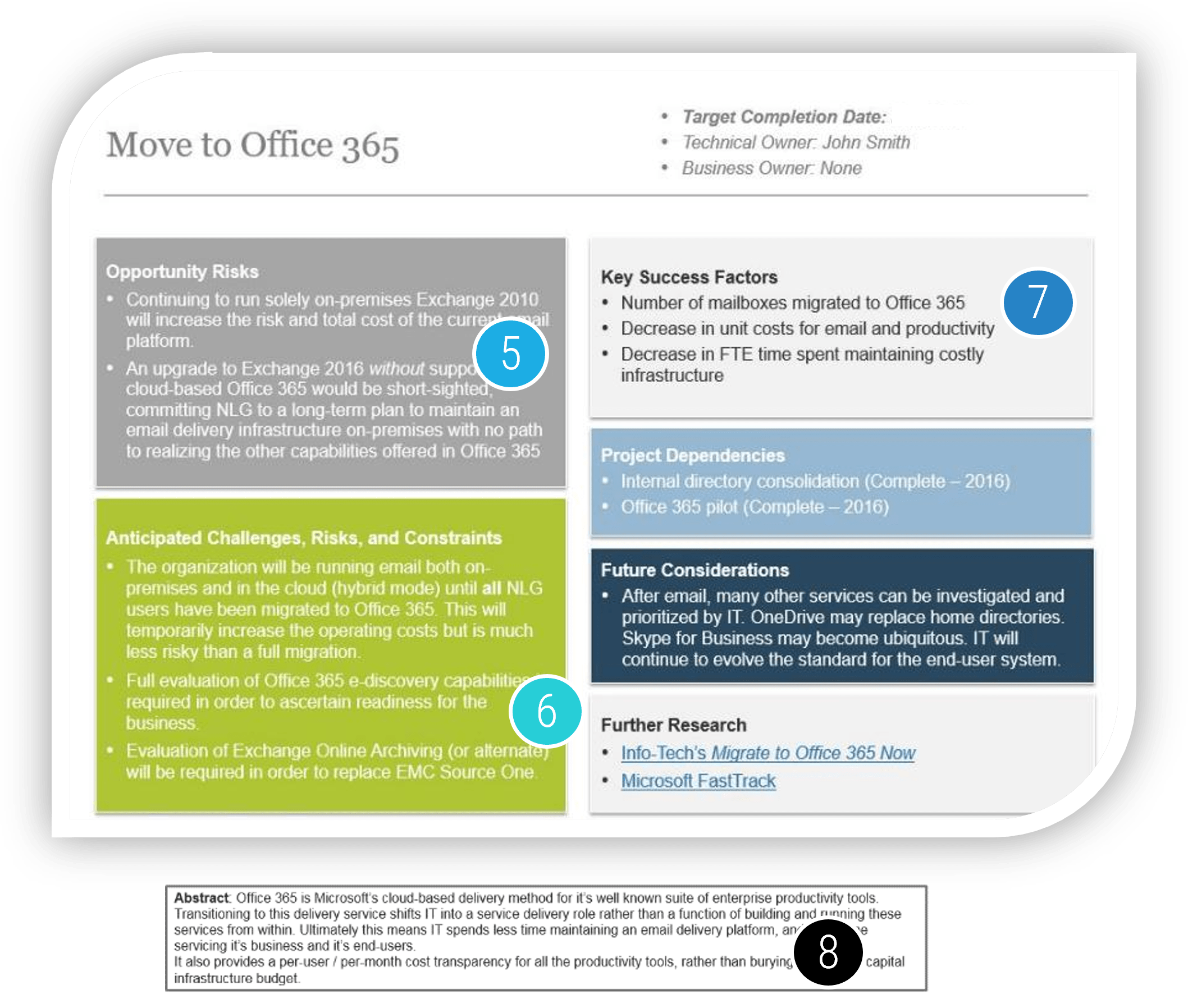
Info-Tech Insight
Every piece of information that is not directly relevant to the interests of the audience is a distraction from the value proposition.
Working session, presentation, and feedback
Rewrite your in-flight initiatives to ensure you're capturing all the required information:
1 hour
- Have each participant select an initiative they are responsible or accountable for.
- Introduce the template and discuss any immediate questions they might have.
- Take 15-20 minutes and have each participant attempt to fill out the template for their initiative.
- Have each participant present their initiative to the group.
- The group should imagine themselves business leaders and push back with questions or clarification when IT jargon is used.
- Look to IT leadership in the room for cues as to what hot button items they've encountered from the business executives.
- Debate the merits of each section in the template. Adjust and customize as appropriate.
Discussion:
Did everyone use the goal framework adopted earlier? Why not?
Are there recurring topics or issues that business leaders always seem concerned about?
Of all the information available, what consistently seems to be the talking points when discussing an initiative?
Input
- In-flight initiatives
Output
- Completed initiatives templates
Materials
- Templates
- Laptops & internet
Participants
- Roadmap team
3.2.2 Visual representations are more compelling than text alone
Being able to quickly sort and filter data allows you to customize the visualization and focus on what matters to your audience. Any data that is not immediately relevant to them risks becoming a distraction.
- Open the Strategic Infrastructure Roadmap Tool, Tabs 6 and 7.
- Up to ten goals can be supported. Input the goals into column F of the tool. Be explicit but brief.
- Initiatives and Obstacles can be independently defined, and the tool supports up to five subdivisions of each. Initiative by origin source makes for an interesting analysis but initially we recommend simplicity.
- Every Initiative and Obstacle must be given a unique name in column H. Context-sensitive drop-downs let you define the subtype and responsible infrastructure domain.
- Three pieces of data are captured for each initiative: Business Impact is the qualitative value to the business; Risk is the qualitative likelihood of failure – entirely or partially (e.g. significantly over budget or delayed); and Effort is a relative measure of magnitude ($ or time). Only the value for Effort must be specified.
- Every initiative can claim to support one or many goals by placing an "x" in the appropriate column(s).
- On Tab 7 you must select the initiative end date (go-live date). You can also document start date, owner, and manager if required. Remember, though, that the tool does not replace proper project management tools.
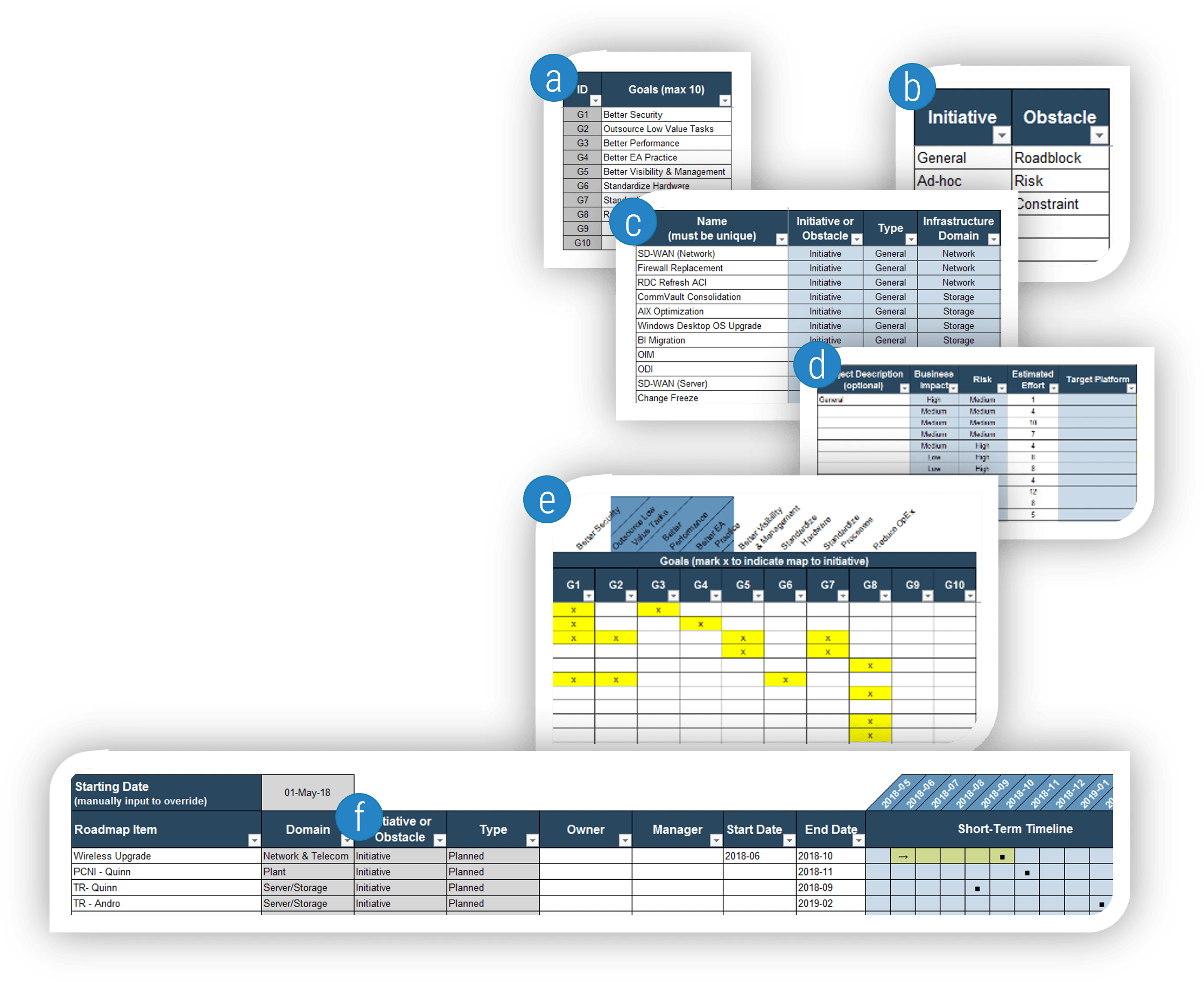
Decoding your visualization
Strategic Infrastructure Roadmap Tool, Tab 8, "Roadmap"
Visuals aren't always as clear as we assume them to be.
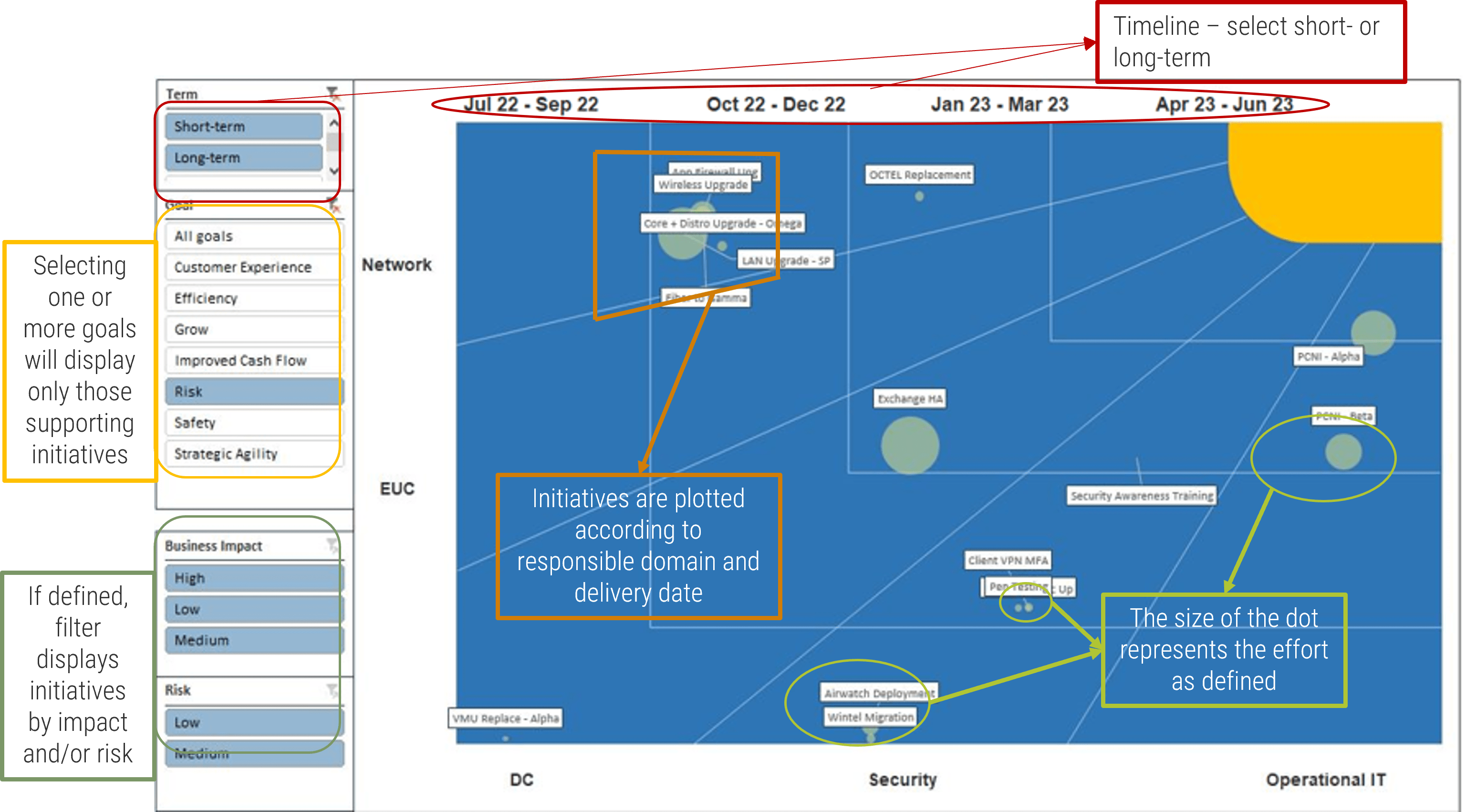
If you could suggest one thing, what would it be?
The roadmap is likely the best and most direct way to showcase our ideas to business leadership – take advantage of it.
We've spent an awful lot of time setting the stage, deciding on frameworks so we agree on what is important. We know how to have an effective conversation – now what do we want to say?
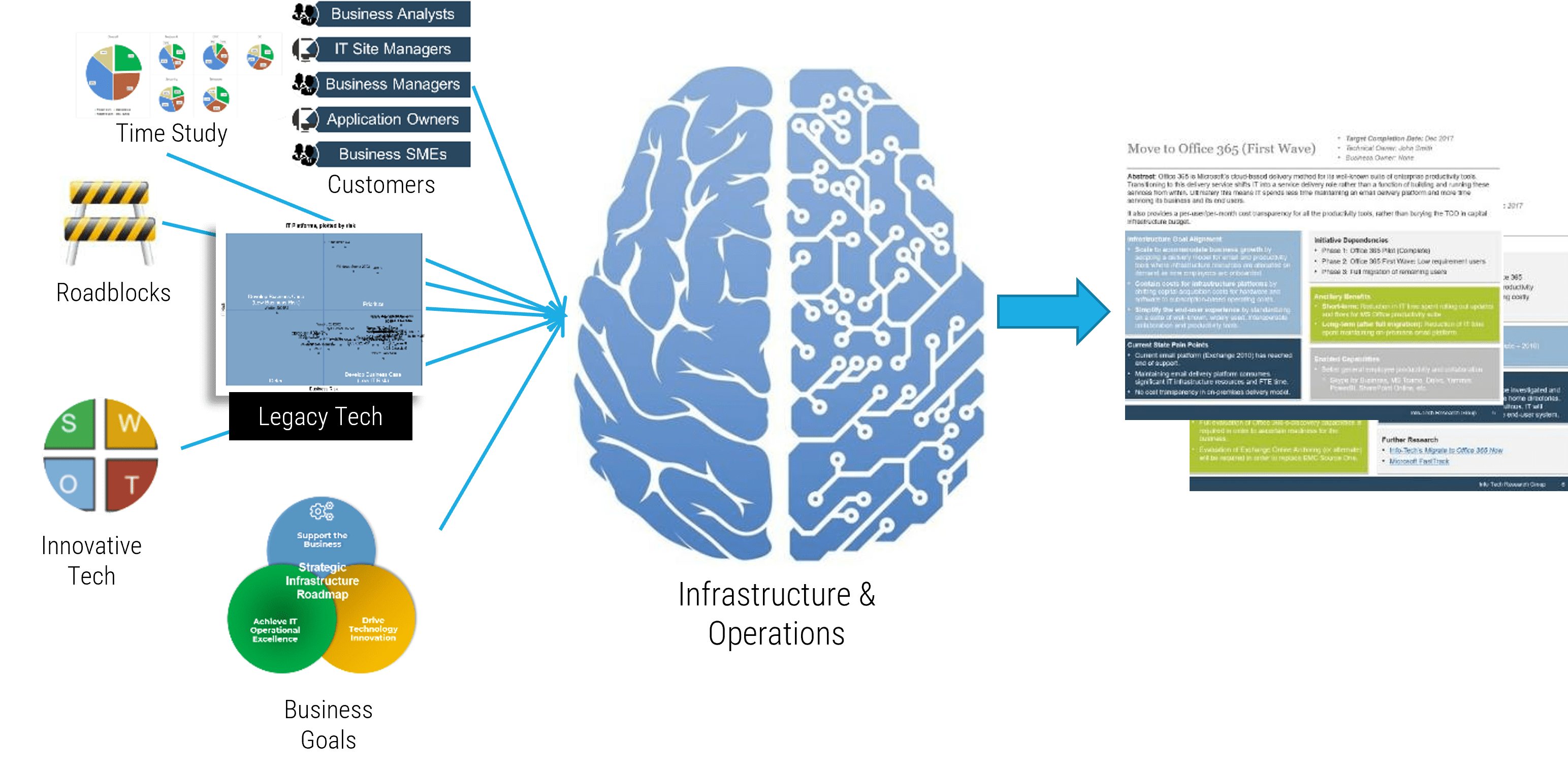
Creative thinking, presentation, and feedback
Since we're so smart – how could we do it better?
1 hour
- Introduce the Roadmap Initiative Template and discuss any immediate questions the participants might have.
- Take 15-20 minutes and have each participant attempt to fill out the template for their initiative candidate.
- Have each author present their initiative to the group.
- The group should imagine themselves business leaders and push back with questions or clarification when IT jargon is used.
- Look to IT leadership in the room for cues as to what hot button items they've encountered from the business executives
- Debate the merits of each section in the template. Adjust and customize as appropriate.
Discussion:
Did everyone use the goal framework adopted earlier? Why not?
Do we think we can find business buy-in or sponsorship? Why or why not?
Are our initiatives at odds with or complementary to the ones proposed through the normal channels?
Input
- Everything we know
Output
- Initiative candidates
Materials
- Info-Tech's Infrastructure Roadmap Initiatives Template
- Laptops & internet
Participants
- Roadmap team
Forced Ranking Exercise
Showcase only your best and brightest ideas:
1 hour
- Write the initiative titles from the previous exercise across the top of a whiteboard.
- Distribute index cards (one per participant) with the initiative titles written down one side.
- Ask each participant to rank the initiatives in order of importance, with 1 being the most important.
- Collect the cards and write the ranking results on the whiteboard.
- Look at the results with an eye toward high variability. Also look for the distribution of 1, 2, and 3 ranks.
- Based on the results, select (through democratic vote or authoritarian fiat – Director or CIO) a reasonable number of initiatives.
- Refine the selected initiative templates for inclusion in the roadmap.
Discussion:
Do participants tend to think their idea is the best and rank it accordingly?
If so, then is it better to look at the second, third, and fourth rankings for consensus instead?
What is a reasonable number of initiatives to suggest? How do we limit ourselves?
Input
- Infrastructure initiative candidates
Output
- Infrastructure initiatives
Materials
- Index cards
Participants
- Roadmap team
Who else might be using technology to solve business problems?
Shadow IT operates outside of the governance and control structure of Enterprise IT and so is, by definition, a problem. an opportunity!
Except for that one thing they do wrong, that one small technicality, they may well do everything else right.
Consider:
- Shadow IT evolves to solve a problem or enable an activity for a specific group of users.
- This infers that because stakeholders spend their own resources resolving a problem or enabling an action, it is a priority.
- The technology choices they've made have been based solely on functionality for value, unrestrained by any legacy of previous decisions.
- Staffing demands and procedural issues must be modest or nonexistent.
- The users must be engaged, receptive to change, and tolerant of stutter steps toward a goal.
In short, shadow IT can provide fully vetted infrastructure initiatives that with a little effort can be turned into easy wins on the roadmap.
Info-Tech Insight
Shadow IT can include business-ready initiatives, needing only minor tweaking to align with infrastructure's best practices.
3.2.3 Survey and hack-a-thon
Negotiate amnesty with shadow IT by evaluating their "hacks" for inclusion on the roadmap.
1 hour
- Put out an open call for submissions across the enterprise. Ask "How do you think technology could help you solve one of your pain points?" Be specific.
- Gather the responses into a presentable format and assemble the roadmap team.
- Use voting dots (three per person) to filter out a shortlist.
- Invite the original author to come in and work with a roadmap team member to complete the template.
- Reassemble the roadmap team and use the forced ranking exercise to select initiatives to move forward.
Discussion:
Did you learn anything from working directly with in-the-trenches staff? Can those learnings be used elsewhere in infrastructure? Or in larger IT?
Input
- End-user ideas
Output
- Roadmap initiatives
Materials
- Whiteboard & markers
- Voting dots
- Index cards
- Templates
Participants
- Enthusiastic end users
- Roadmap team
- Infrastructure leader
3.2.4 Consensus estimation
Exploit the wisdom of groups to develop reasonable estimates.
1 hour
Also called scrum poker (in Agile software circles), this method reduces anchoring bias by requiring all participants to formulate and submit their estimates independently and simultaneously.
Equipment: A typical scrum deck shows the Fibonacci sequence of numbers, or similar progression, with the added values of ∞ (project too big and needs to be subdivided), and a coffee cup (need a break). Use of the (mostly) Fibonacci sequence helps capture the notional uncertainty in estimating larger values.
- The infrastructure leader, who will not play, moderates the activity. A "currency" of estimation is selected. This could be person, days, or weeks, or a dollar value in the thousands or tens of thousands – whatever the group feels they can speak to authoritatively.
- The author of each initiative gives a short overview, and the participants are given the chance to ask questions and clarify assumptions and risks.
- Participants lay a card representing their estimate face down on the table. Estimates are revealed simultaneously.
- Participants with the highest and lowest estimates are given a soapbox to offer justification. The author is expected to provide clarifications. The moderator drives the conversation.
- The process is repeated until consensus is reached (decided by the moderator).
- To structure discussion, the moderator can impose time limits between rounds.
Discussion:
How often was the story unclear? How often did participants have to ask for additional information to make their estimate? How many rounds were required to reach consensus?
Does number of person, days, or weeks, make more sense than dollars? Should we estimate both independently?
Source: Scrum Poker
Input
- Initiative candidates from previous activity
Output
- Resourcing estimates
Materials
- Scrum poker deck
Participants
- Roadmap team
Hard work up front allows for year-over-year comparisons
Open the Strategic Infrastructure Roadmap Tool, Tab 6, "Initiatives & Goals" and Tab 7, "Timeline"
Add your ideas to the visualization.
- An initiative subtype can be useful here to differentiate infrastructure-sponsored initiatives from traditional ones.
- Goal alignment is as important as always – ideally you want your sponsored initiatives to fill gaps or support the highest-priority business goals.
- The longer-term roadmap is an excellent parking lot for ideas, especially ones the business didn't even know they wanted. Make sure to pull those ideas forward, though, as you repeat the process periodically.
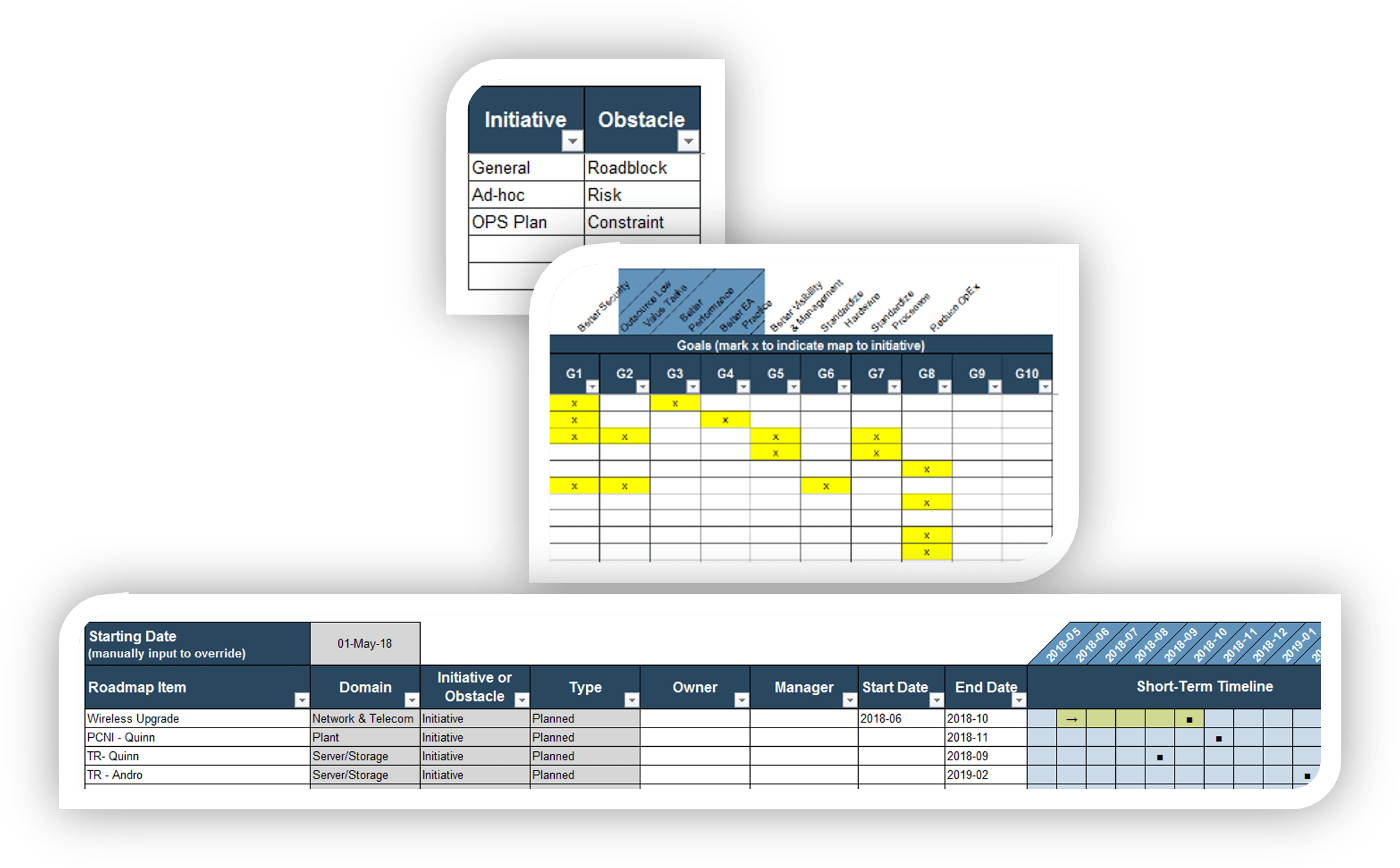
Pulling it all together – the published report
We started with eight simple questions. Logically, the answers suggest sections for a published report. Developing those answers in didactic method is effective and popular among technologists as answers build upon each other. Business leaders and journalists, however, know never to bury the lead.
| Report Section Title | Roadmap Activity or Step |
|---|---|
| Sunshine diagram | Visualization |
| Priorities | Understand business goals |
| Who we help | Evaluate intake process |
| How we can help | Create initiatives |
| What we're working on | Review initiatives |
| How you can help us | Assess roadblocks |
| What is new | Assess new technology |
| How we spend our day | Conduct a time study |
| What we have | Assess IT platform |
| We can do better! | Identify process optimizations |
Summary of Accomplishment
Review performance from last fiscal year
- Analyzed and communicated the benefits and value realized from IT's strategic initiatives in the past fiscal year.
- Analyzed and prioritized diagnostic data insights to communicate IT success stories.
- Elicited important retrospective information such as KPIs, financials, etc. to build IT's credibility as a strategic business partner.
If you would like additional support, have our analysts guide you through other phases as part of an Info-Tech workshop
Contact your account representative for more information.
workshops@infotech.com 1-888-670-8889
Phase 4
Communicate and Improve the Process
Phase 1 | Phase 2 | Phase 3 | Phase 4 |
|---|---|---|---|
1.1 Infrastructure strategy 1.2 Goal alignment | 2.1 Define your future 2.2 Conduct constraints analysis | 3.1 Drive business alignment 3.2. Build the roadmap | 4.1 Identify the audience 4.2 Process improvement and measurements |
This phase will walk you through the following activities:
- Identify authors and target audiences
- Understand the planning process
- Identify if the process outputs have value
- Set up realistic KPIs
This phase involves the following participants:
- CIO
- Roadmap team
Step 4.1
Identify the audience
Activities
4.1.1 Identify required authors and target audiences
4.1.2 Planning the process
4.1.3 Identifying supporters and blockers
This step requires the following inputs:
- Identify required authors and target audiences
- Plan the process
- Identify supporters and blockers
This step involves the following participants:
- CIO
- Roadmap team
Outcomes of this step
- Process schedule
- Communication strategy
Again! Again!
And you thought we were done. The roadmap is a process. Set a schedule and pattern to the individual steps.
Publishing an infrastructure roadmap once a year as a lead into budget discussion is common practice. But this is just the last in a long series of steps and activities. Balance the effort of each activity against its results to decide on a frequency. Ensure that the frequency is sufficient to allow you to act on the results if required. Work backwards from publication to develop the schedule.
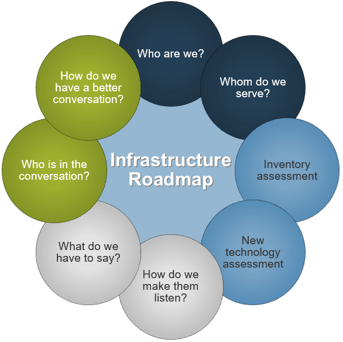
A lot of work has gone into creating this final document. Does a single audience make sense? Who else may be interested in your promises to the business? Look back at the people you've asked for input. They probably want to know what this has all been about. Publish your roadmap broadly to ensure greater participation in subsequent years.
4.1.1 Identify required authors and target audiences
1 hour
Identification and association
Who needs to hear (and more importantly believe) your message? Who do you need to hear from? Build a communications plan to get the most from your roadmap effort.
- Write your eight roadmap section titles in the middle of a whiteboard.
- Make a list of everyone who answered your questions during the creation of this roadmap. Write these names on a single color of sticky notes and place them on the left side.
- Make a list of everyone who would be (or should be) interested in what you have to say. Write these names on a different single color of sticky notes and place them on the right side.
- Draw lines between the stickies and the relevant section of the roadmap. Solid lines indicate a must have communication while dashed lines indicate a nice-to-have communication.
- Come to a consensus.
Discussion:
How many people appear in both lists? What are the implications of that?
Input
- Roadmap sections
Output
- Roadmap audience and contributors list
Materials
- Whiteboard & markers
- Sticky notes
Participants
- Roadmap team
4.1.2 Planning the process and scheduling
The right conversation at the right time
| Due Date (t) | Freq | Mode | Participants | Infrastructure Owner | |
|---|---|---|---|---|---|
| Update & Publish | Start of Budget Planning |
Once |
Report |
IT Steering Committee |
Infrastructure Leader or CIO |
| Evaluate Intakes | (t) - 2 months (t) - 8 months |
Biannually |
Review |
PMO Service Desk |
Domain Heads |
| Assess Roadblocks | (t) - 2 months (t) - 5 months (t) - 8 months (t) - 11 months |
Quarterly |
Brainstorming & Consensus |
Domain Heads |
Infrastructure Leader |
| Time Study | (t) - 1 month (t) - 4 months (t) - 7 months (t) - 10 months |
Quarterly |
Assessment |
Domain Staff |
Domain Heads |
| Inventory Assessment | (t) - 2 months |
Annually |
Assessment |
Domain Staff |
Domain Heads |
| Business Goals | (t) - 1 month |
Annually |
Survey |
Line of Business Managers |
Infrastructure Leader or CIO |
| New Technology Assessment | monthly (t) - 2 months |
Monthly/Annually |
Process |
Domain Staff |
Infrastructure Leader |
| Initiative Review | (t) - 1 month (t) - 4 months (t) - 7 months (t) - 10 months |
Quarterly |
Review |
PMO Domain Heads |
Infrastructure Leader |
| Initiative Creation | (t) - 1 month |
Annually |
Brainstorming & Consensus |
Roadmap Team |
Infrastructure Leader |
The roadmap report is just a point-in-time snapshot, but to be most valuable it needs to come at the end of a full process cycle. Know your due date, work backwards, and assign responsibility.
Discussion:
- Do each of the steps make sense? Is the outcome clear and does it flow naturally to where it will be useful?
- Is the effort required for each step commensurate with its value? Are we doing to much for not enough return?
- Are we acting on the information we're gathering? Is it informing or changing decisions throughout the year or period?
Input
- Roadmap sections
Output
- Roadmap process milestones
Materials
- Whiteboard & markers
- Template
Participants
- Roadmap team
Tailor your messaging to secure stakeholders' involvement and support
If your stakeholders aren't on board, you're in serious trouble.
Certain stakeholders will not only be highly involved and accountable in the process but may also be responsible for approving the roadmap and budget, so it's essential that you get their buy-in upfront.
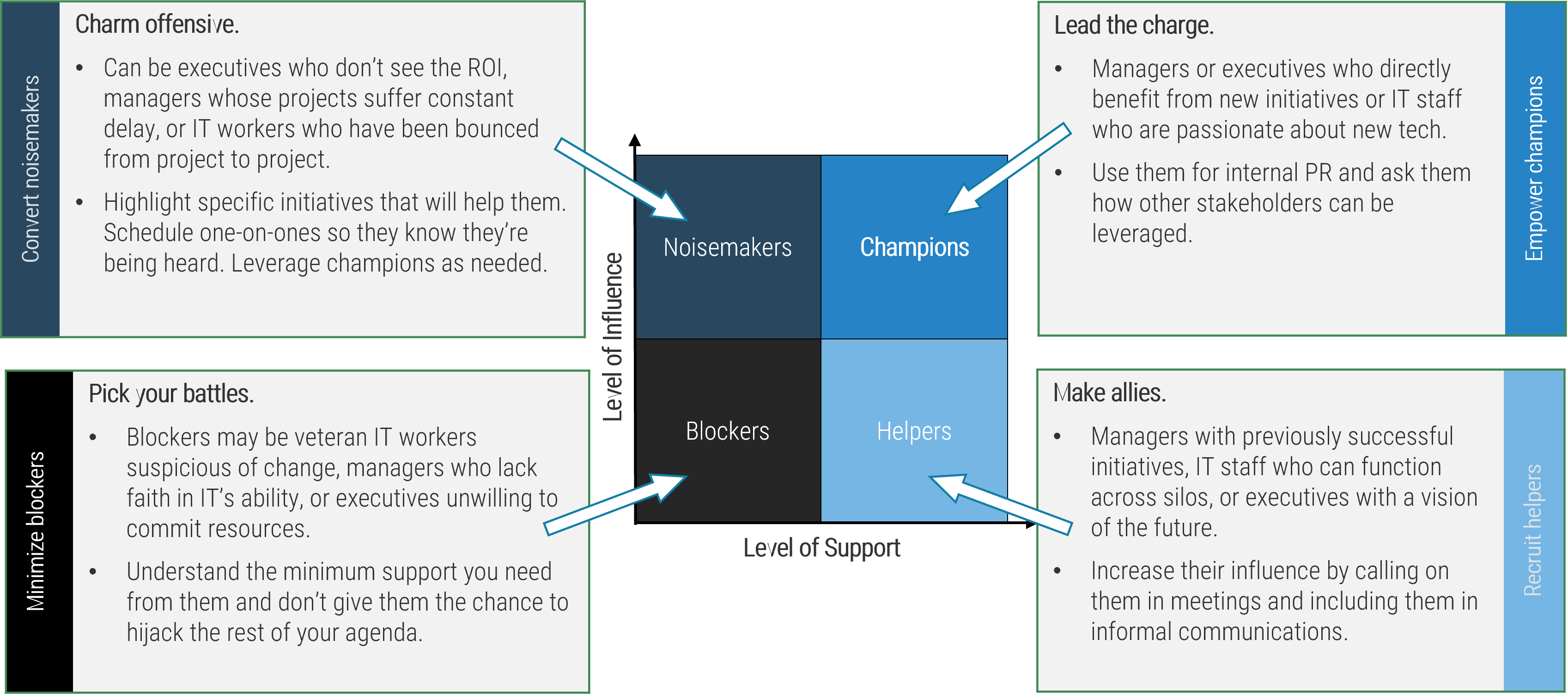

4.1.3 Identifying supporters and blockers
Classification and Strategy
1 hour
You may want to restrict participation to senior members of the roadmap team only.
This activity requires a considerable degree of candor in order to be effective. It is effectively a political conversation and as such can be sensitive.
Steps:
- Review your sticky notes from the earlier activity (list of input and output names).
- Place each name in the corresponding quadrant of a 2x2 matrix like the one on the right.
- Come to a consensus on the placement of each sticky note.
Input
- Roadmap audience and contributors list
Output
- Communications strategy & plan
Materials
- Whiteboard & markers
- Sticky notes
Participants
- Senior roadmap team
Step 4.2
Process improvement
Activities
4.2.1 Evaluating the value of each process output
4.2.2 Brainstorming improvements
4.2.3 Setting realistic measures
This step requires the following inputs:
- Evaluating the efficacy of each process output
- Brainstorming improvements
- Setting realistic measures
This step involves the following participants:
- Roadmap team
Outcomes of this step
- Process map
- Process improvement plan
Continual improvement
Not just for the DevOps hipsters!
You started with a desire – greater satisfaction with infrastructure from the business. All of the inputs, processes, and outputs exist only, and are designed solely, to serve the attainment of that outcome.
The process outlined is not dogma; no element is sacrosanct. Ruthlessly evaluate the effectiveness of your efforts so you can do better next time.
You would do no less after a server migration, network upgrade, or EUC rollout.
Consider these four factors to help make your infrastructure roadmap effort more successful.
Leadership
If infrastructure leaders aren't committed, then this will quickly become an exercise of box-checking rather than candid communication.
Data
Quantitative or qualitative – always try to go where the data leads. Reduce unconscious bias and be surprised by the insight uncovered.
Metrics
Measurement allows management but if you measure the wrong thing you can game the system, cheating yourself out of the ultimate prize.
Focus
Less is sometimes more.
4.2.1 Evaluating the value of each process output
Understanding why and how individual steps are effective (or not) is how we improve the outcome of any process.
1 hour
- List each of the nine roadmap steps on the left-hand side of a whiteboard.
- Ask the participants "Why was this step included? Did it accomplish its objective?" Consider using a reduced scale affinity diagramming exercise for this step.
- Consider the priority characteristics of each step; try to be as universal as possible (every characteristic will ideally apply to each step).
- Include two columns at the far right: "Improvement" and "Expected Change."
- Populate the table. If this is your first time, brainstorm reasonable objectives for your left-hand columns. Otherwise, document the reality of last year and focus on brainstorming the right-hand columns.
- Optional: Conduct a thought experiment and brainstorm tension metrics to establish whether the process is driving the outcomes we desire.
- Optional: Consider Info-Tech's assertion about the four things a roadmap can do. Brainstorm KPIs that you can measure yearly. What else would you want the roadmap to be able to do?
Discussion:
Did the group agree on the intended outcome of each step? Did the group think the step was effective? Was the outcome clear and did it flow naturally to where it was useful?
Is the effort required for each step commensurate with its value? Are we doing too much for not enough return?
Are we acting on the information we're gathering? Is it informing or changing decisions throughout the year or period?
Input
- Roadmap process steps
Output
- Process map
- Improvement targets & metrics
Materials
- Whiteboard & markers
- Sticky notes
- Process Map Template (see next slide)
Participants
- Roadmap team
Process map template
Replace the included example text with your inputs.
| Freq. | Method | Measures | Success criteria | Areas for improvement | Expected change | |
|---|---|---|---|---|---|---|
| Evaluate intakes | Biannually | PMO Intake & Service Requests | Projects or Initiatives | % of departments engaged | Actively reach out to underrepresented depts. | +10% engagement |
| Assess roadblocks | Quarterly | IT All-Staff Meeting | Roadblocks | % of identified that have been resolved | Define expected outcomes of removing roadblock | Measurable improvements |
| Time study | Quarterly | IT All-Staff Meeting | Time | Confidence value of data | Real data sources (time sheets, tools, etc.) | 85% of sources defensible |
| Legacy asset assessment | Annually | Domain effort | Asset Inventory | Completeness of Inventory |
|
|
| Understand business goals | Annually | Roadmap Meeting | Goal list | Goal specificity | Survey or interview leadership directly | 66% directly attributable participation |
| New technology assessment | Monthly/Annually | Team/Roadmap Meeting | Technologies Reviewed | IT staff participation/# SWOTs | Increase participation from junior members | 50% presentations from junior members |
Initiative review | Quarterly | IT All-Staff Meeting |
|
|
|
|
Initiative creation | Annually | Roadmap Meeting | Initiatives | # of initiatives proposed | Business uptake | +25% sponsorship in 6 months (biz) |
Update and publish | Annually | PDF report | Roadmap Final Report | Leadership engagement | Improve audience reach | +15% of LoB managers have read the report |
Establish baseline metrics
Baseline metrics will improve through:
- Increased communication. More information being shared to more people who need it.
- Better planning. More accurate information being shared.
- Reduced lead times. Less due diligence or discovery work required as part of project implementations.
- Faster delivery times. Less less-valuable work, freeing up more time to project work.
| Metric description | Current metric | Future goal |
|---|---|---|
| # of critical incidents resulting from equipment failure per month | ||
| # of service provisioning delays due to resource (non-labor) shortages | ||
| # of projects that involve standing up untested (no prior infrastructure PoC) technologies | ||
| # of PoCs conducted each year | ||
| # of initiatives proposed by infrastructure | ||
| # of initiatives proposed that find business sponsorship in >1yr | ||
| % of long-term projects reviewed as per goal framework | ||
| # of initiatives proposed that are the only ones supporting a business goal | ||
| # of technologies deployed being used by more than the original business sponsor | ||
| # of PMO delays due to resource contention |
Insight Summary
Insight 1
Draw the first picture.
Highly engaged and effective team members are proactive rather than reactive. Instead of waiting for clear inputs from the higher ups, take what you do know, make some educated guesses about the rest, and present that to leadership. Where thinking diverges will be crystal clear and the necessary adjustments will be obvious.
Insight 2
Infrastructure must position itself as the broker for new technologies.
No man is an island; no technology is a silo. Infrastructure's must ensure that everyone in the company benefits from what can be shared, ensure those benefits are delivered securely and reliably, and prevent the uninitiated from making costly technological mistakes. It is easier to lead from the front, so infrastructure must stay on top of available technology.
Insight 3
The roadmap is a process that is business driven and not a document.
In an ever-changing world the process of change itself changes. We know the value of any specific roadmap output diminishes quickly over time, but don't forget to challenge the process itself from time to time. Striving for perfection is a fool's game; embrace constant updates and incremental improvement.
Insight 4
Focus on the framework, not the output.
There usually is no one right answer. Instead make sure both the business and infrastructure are considering common relevant elements and are working from a shared set of priorities. Data then, rather than hierarchical positioning or a d20 Charisma roll, becomes the most compelling factor in making a decision. But since your audience is in hierarchical ascendency over you, make the effort to become familiar with their language.
4.2.3 Track metrics throughout the project to keep stakeholders informed
An effective strategic infrastructure roadmap should help to:
- Initiate a schedule of infrastructure projects to achieve business goals.
- Adapt to feedback from executives on changing business priorities.
- Curate a portfolio of enabling technologies that align to the business whether growing or stabilizing.
- Manage the lifecycle of aging equipment in order to meet capacity demands.
| Metric description | Metric goal |
Checkpoint 1 |
Checkpoint 2 |
Checkpoint 3 |
|---|---|---|---|---|
| # of critical incidents resulting from equipment failure per month | >1 | |||
| # of service provisioning delays due to resource (non-labor) shortages | >5 | |||
| # of projects that involve standing up untested (no prior infrastructure PoC) technologies | >10% | |||
| # of PoCs conducted each year | 4 | |||
| # of initiatives proposed by infrastructure | 4 | |||
| # of initiatives proposed that find business sponsorship in >1 year | 1 | |||
| # of initiatives proposed that are the only ones supporting a business goal | 1 | |||
| % of long-term projects reviewed as per goal framework | 100% |
Summary of Accomplishment
Review performance from last fiscal year
- Analyzed and communicated the benefits and value realized from IT's strategic initiatives in the past fiscal year.
- Analyzed and prioritized diagnostic data insights to communicate IT success stories.
- Elicited important retrospective information such as KPIs, financials, etc. to build IT's credibility as a strategic business partner.
If you would like additional support, have our analysts guide you through other phases as part of an Info-Tech workshop
Contact your account representative for more information.
workshops@infotech.com 1-888-670-8889
Related Info-Tech Research
Build a Business-Aligned IT Strategy
Success depends on IT initiatives clearly aligned to business goals, IT excellence, and driving technology innovation.
Document your Cloud Strategy
A cloud strategy might seem like a big project, but it's just a series of smaller conversations. The methodology presented here is designed to facilitate those conversations using a curated list of topics, prompts, participant lists, and sample outcomes. We have divided the strategy into four key areas.
Develop an IT Asset Management Strategy
ITAM is a foundational IT service that provides accurate, accessible, actionable data on IT assets. But there's no value in data for data's sake. Enable collaboration between IT asset managers, business leaders, and IT leaders to develop an ITAM strategy that maximizes the value they can deliver as service provider.
Infrastructure & Operations Research Center
Practical insights, tools, and methodologies to systematically improve IT Infrastructure & Operations.
Summary of Accomplishment
Knowledge gained
- Deeper understanding of business goals and priorities
- Key data the business requires for any given initiative
- Quantification of risk
- Leading criteria for successful technology adoption
Processes optimized
- Infrastructure roadmap
- Initiative creation, estimation, evaluation, and prioritization
- Inventory assessment for legacy infrastructure debt
- Technology adoption
Deliverables completed
- Domain time study
- Initiative intake analysis
- Prioritized roadblock list
- Goal listing
- IT and business risk frameworks
- Infrastructure inventory assessment
- New technology analyzes
- Initiative templates
- Initiative candidates
- Roadmap visualization
- Process schedule
- Communications strategy
- Process map
- Roadmap report
If you would like additional support, have our analysts guide you through other phases as part of an Info-Tech workshop
Contact your account representative for more information.
workshops@infotech.com 1-888-670-8889
Bibliography
"10 Essential KPIs for the IT Strategic Planning Process." Apptio Inc, Dec. 2021. Accessed Nov. 2022.
Amos, Justin. "8 areas your 2022 IT Infrastructure roadmap should cover." Soma, 24 Jan 2022 Accessed Nov. 2022
Ahmed, Anam. "Importance of Mission Vision in Organizational Strategy." Chron, 14 March 2019. Accessed 10 May 2021. ."
Barker, Joel A. "Joel A Barker Quote about Vision." Joel A Barker.com. Accessed 10 Nov 2022
Bhagwat, Swapnil ."Top IT Infrastructure Management Strategies For 2023 , Atlas Systems, 23 Oct 2022. Accessed Nov. 2022.
Blank, Steve. "You're Better Off Being A Fast Follower Than An Originator." Business Insider. 5 Oct. 2010. Web.
Bridges, Jennifer . "IT Risk Management Strategies and Best Practices." Project Manager, 6 Dec 2019. Accessed Nov. 2022.
"Building a Technology Roadmap That Stabilizes and Transforms." Collegis Education. Accessed Dec 2022.
Collins, Gavin. "WHY AN IT INFRASTRUCTURE ROAD MAP?." Fifth Step, Date unknown. Accessed Nov. 2022.
"Define the Business Context Needed to Complete Strategic IT Initiatives: 2018 Blueprint - ResearchAndMarkets.com." Business Wire, 1 Feb. 2018. Accessed 9 June 2021.
De Vos, Colton. “Well-Developed IT Strategic Plan Example." Resolute Tech Solutions, 6 Jan 2020. Accessed Nov. 2022.
Gray, Dave. "Post-Up." Gamestorming, 15 Oct. 2010. Accessed 10 Nov 2022
Helm, Clay. "Majority of Surveyed Companies are Not Prepared for IT Needs of the Future." IBM Study, 4 Jan 2021. Accessed Nov. 2022.
Hertvik, Joe. "8 Components of A Great IT Strategy, BMC Blogs, 29 May. 2020. Accessed Nov. 2022.
ISACA, "Effective governance at your Fingertips". COBIT Framework, Accessed Dec 2022
"IT Guiding Principles." Office of Information Technology, NC State University, 2014-2020. Accessed 9 Nov 2022.
""IT Infrastructure That Makes Employees Happier." Network Doctor, 2021. Accessed Dec 2022
"IT Road mapping Helps Dura Remain at the Forefront of Auto Manufacturing." Performance Improvement Partners, ND. Accessed Dec 2022.
ITtoolkit.com. "The IT Vision: A Strategic Path to Lasting IT Business Alignment." ITtoolkit Magazine, 2020. Accessed 9 June 2021.
Kark, Khalid. "Survey: CIOs Are CEOs' Top Strategic Partner." CIO Journal, The Wall Street Journal, 22 May 2020. Accessed 11 May 2021.
Kimberling, Eric. "What is "Future State" and Why is it Important?" Third Stage Consulting, 11 June 2021. Accessed Nov. 2022.
Kishore. "The True Cost of Keeping the Lights On." Optanix, 1 Feb. 2017. Accessed Nov. 2022.
Lakein, Alan. Libquotes.
Mindsight. "THE ULTIMATE GUIDE TO CREATING A TECHNOLOGY ROADMAP" Mind sight, 12 Dec 2021. Accessed Nov. 2022.
Milani, F. (2019). Future State Analysis. In: Digital Business Analysis. Springer, Cham. https://doi.org/10.1007/978-3-030-05719-0_13
Newberry, Dennis. "Meeting the Challenges of Optimizing IT Cost and Capacity Management." BMC, 2021, Accessed 12 Nov 2022.
Peek, Sean. "What Is a Vision Statement?" Business News Daily, 7 May 2020. Accessed 10 Nov 2022.
Ramos, Diana. "Infrastructure Management 101: A Beginner's Guide to IT Infrastructure Management." Smartsheet.com. 30 Nov 2021. Accessed 09 Dec 2022.
Ramsey, Dave. "Dave Rant: How to Finally Take Control of Your Money." Ramseysolutions. 26 Aug 2021. Accessed 10 Nov 2022.
Richards-Gustafson, Flora. "5 Core Operational Strategies." Chron, 8 Mar 2019. Accessed 9 June 2021.
Richardson, Nigel. "What are the differences between current and future state maps?." Nexus, 18 Oct 2022. Accessed Nov. 2022.
Roush, Joe. "IT Infrastructure Planning: How To Get Started." BMC. 05 January, 2018. Accessed 24 Jan 2023.
Shields, Corey. "A Complete Guide to IT Infrastructure Management." Ntiva, 15 Sept. 2020. Accessed 28 Nov. 2022.
Snow, Shane. "Smartcuts: How Hackers, Innovators, and Icons Accelerate Success." Harper Business, 2014.
Strohlein, Marc. "The CIO's Guide to Aligning IT Strategy with the Business." IDC, 2019. Accessed Nov 2022.
Sull, Sull, and Yoder. "No One Knows Your Strategy — Not Even Your Top Leaders." MIT Sloan. 12 Feb 2018. Accessed 26 Jan 2023.
"Team Purpose & Culture." Hyper Island. Accessed 10 Nov. 2022
"Tech Spend Pulse, 2022." Flexera, Jan 2022, Accessed 15 Nov 2022
"Tech Spend Pulse." Flexera, Dec. 2022. Accessed Nov. 2022.
"The Definitive Guide to Developing an IT Strategy and Roadmap" CIO Pages.com , 5 Aug 13 2022. Accessed 30 Nov. 2022.
Wei, Jessica. "Don't Tell Me Where Your Priorities Are – James W. Frick." Due.com, 21 Mar 2022. Accessed 23 Nov 2022.
Zhu, Pearl. "How to Set Guiding Principles for an IT Organization." Future of CIO, 1 July 2013. Accessed 9 June 2021.